16.1: South American Civilizations
16.1.1: The Moche
The Moche culture lasted from 100 to 800 CE in what is modern-day Peru.
Learning Objective
Identify key aspects of Moche life
Key Points
- The Moche were less of a state or empire and more of a society—they lived in a general geographic area and shared cultural values, but were not governed under a uniform political system.
- The Moche practiced a number of religious rituals, some of which involved human sacrifice.
- Moche art appears in a variety of mediums, such as ceramics, architecture, and textiles, and lends insight into their beliefs and culture.
Key Terms
- Decapitator
-
A Moche icon, usually depicted as a spider, and associated with ritual sacrifices and the elements of land, air, and water.
- Moche
-
A city in modern-day Peru, which is also where the Moche culture was centered.
- vicuña
-
A wild South American camelid that lives in the high alpine areas of the Andes. It is a relative of the llama, and is now believed to be the wild ancestor of domesticated alpacas, which are raised for their coats.
- Huaca
-
A large, pyramid-like structure made of adobe bricks and used as a palace, ritual site, temple, and administrative center.
The Moche (also known as the Early Chimú or Mochica) lived in what is modern-day Peru, near Moche and Trujillo. Their civilization lasted from approximately 100 to 800 CE. The Moche shared cultural values and social structures within a distinct geographical region. However, scholars suggest this civilization functioned as individual city-states, sharing similar cultural elite classes, rather than as an empire or a single political system.
The Moche cultural sphere centered around several valleys along the north coast of Peru, and occupied 250 miles of desert coastline that extended up to 50 miles inland. Moche society was agriculturally based, but because of the arid climate, they invested heavily in the construction of a network of irrigation canals. These ornate canals diverted river water to crops across the region. The Moche are also noted for their expansive ceremonial architecture (huacas), elaborately painted ceramics, and woven textiles.
Religion
Both iconography and the discovery of human skeletons in ritual contexts seem to indicate that human sacrifice played a significant part in Moche religious practices. These rites appear to have involved the elite, both ruling men and women, as key actors in an elaborate spectacle. These rituals included:
- Costumed participants, including elite priests and priestesses, many of which also ruled the city-states;
- Monumental settings, including the pyramid-like structures called huacas; and
- Likely the consumption of human blood and possibly flesh as a part of a renewal ritual.
The Moche may have also held and tortured the victims for several weeks before sacrificing them, with the intent of deliberately drawing blood. The sacrifices may have been associated with rites of ancestral renewal and agricultural fertility.
Moche iconography features a figure, which scholars have nicknamed the “Decapitator” or Ai Apaec. It is frequently depicted as a spider, but sometimes as a winged creature or a sea monster. Together, all three features symbolize land, water, and air. When the body is included, the figure is usually shown with one arm holding a knife and another holding a severed head by the hair. It has also been depicted as “a human figure with a tiger’s mouth and snarling fangs.”
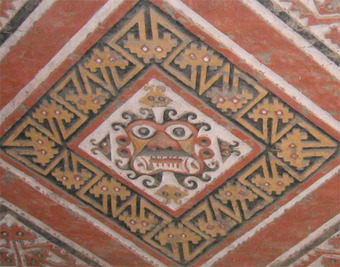
Moche Decapitator
A mural depicting the Decapitator, a central Moche icon of the land, water, and air as well as a figure of death and renewal.
Architecture
The Huaca del Sol, a pyramidal adobe structure on the Rio Moche, was the largest pre-Columbian structure in Peru. Huacas were the centerpieces for ritual sites and used as administrative centers and palaces for Moche culture. However, the Huaca del Sol was partly destroyed when Spanish Conquistadores mined its graves for gold in the 16th century. During the Spanish occupation of Peru in the early 17th century, colonists redirected the waters of the Moche River to run past the base of the Huaca del Sol in order to facilitate the looting of gold artifacts from the temple, which caused massive erosion. In total, approximately two-thirds of the structure has been lost to erosion and such looting. The remaining structure stands at a height of 41 meters (135 feet). Looting and erosion due to El Niño continue to be major concerns to this day
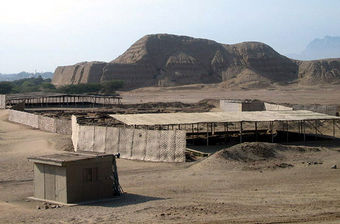
Huaca del Sol
Originally the largest pre-Columbian adobe structure in the Americas, this pyramid was constructed using around 130 million bricks.
The nearby Huaca de la Luna is better preserved. Its interior walls contain many colorful murals with complex iconography. The site has been under professional archaeological excavation since the early 1990s.
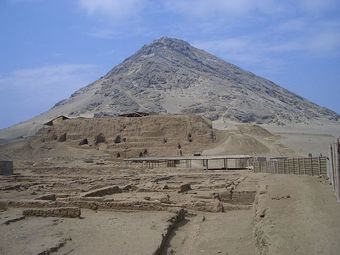
A view of the Huaca de la Luna, with Cerro Blanco in the background
When this structure was originally completed it would have been covered in brightly painted murals in yellows, blues, reds, and black.
Art
The Moche are well known for their art, especially their naturalistic and articulate ceramics, particularly in the form of stirrup-spout vessels. The ceramics incorporate a wide-ranging subject matter, both in shape and painted decorations, including representations of people, animals, and ritual scenes. They also feature gods hunting, scenes of war, music making, visiting rulers, burying the dead, curing the sick, and anthropomorphic iconography. Moche ceramics illustrate these recurring narrative themes, which help illuminate and define their ideologies in the present day.
Some of the ceramics have become known as “sex-pots”: vessels depicting sexual acts. It is thought that these vessels were used for didactic purposes, and also as articulations of Moche culture. Because irrigation was the source of wealth and foundation of the empire, the Moche culture emphasized the importance of circulation and flow. Sexual themes in the pottery are posited to reflect Moche views of bodily fluids as an essential life force.
The Moche also wove textiles, mostly using wool from vicuñas and alpacas. Although there are few surviving examples of this, descendants of the Moche people have strong weaving traditions.
Collapse
There are several theories as to what caused the demise of the Moche political structure. Some scholars have emphasized the role of environmental change. Studies of ice cores drilled from glaciers in the Andes reveal climatic events between 536 and 594 CE, possibly a super El Niño, that resulted in thirty years of intense rain and flooding followed by thirty years of drought, part of the aftermath of the climate changes of 535–536. These weather events could have disrupted the Moche way of life and shattered their faith in their religion, which had promised stable weather through sacrifices.
Other evidence demonstrates that these events did not cause the final Moche demise. Moche polities survived beyond 650 in the Jequetepeque Valley and the Moche Valleys. For instance, in the Jequetepeque Valley, later settlements are characterized by fortifications and defensive works. While there is no evidence of a foreign invasion, as many scholars have suggested in the past, the defensive works suggest social unrest, possibly the result of climate change, as factions fought for control over increasingly scarce resources.
16.1.2: The Nazca
The Nazca lived near the southern coast of Peru from 100 BCE to 800 CE.
Learning Objective
Explain the culture, religion, agriculture, and decline of the Nazca civilization
Key Points
- Early Nazca society was made up of local chiefdoms and regional centers of power centered around the ritual site of Cahuachi.
- The Nazca are known for their Nazca Lines—geometric shapes, lines, and animal figures carved into the desert floor.
- Like the Moche, the Nazca decline was likely due to environmental changes.
Key Terms
- Nazca Lines
-
A series of geometric shapes, miles of lines, and large drawings of animal figures created by the Nazca culture.
- shamans
-
Spiritual practitioners that reach altered states of consciousness in order to encounter and interact with the spirit world and channel these transcendental energies into this world for healing and divination purposes.
- Trephination
-
This primitive surgery removed a piece of bone from the skull, while the person was still alive, to allow drainage after a head injury.
The Nazca (or Nasca) lived near the arid southern coast of Peru from 100 BCE to 800 CE. Early Nazca society was made up of local chiefdoms and regional centers of power centered around Cahuachi, a non-urban ceremonial site of earthwork mounds and plazas. These pyramid-like structures and plazas, situated in the lower part of the Nazca Valley, served as important spaces for fertility and agricultural rituals. People from across the Nazca region most likely gathered in Cahuachi during specific times of the year to feast and make offerings.
The Nazca developed underground aqueducts, named puquios, to sustain cities and agriculture in this arid climate. Many of them still function today. They also created complex textiles and ceramics reflecting their agricultural and sacrificial traditions.
Society and Religion
Likely related to the arid and extreme nature of the environment, Nazca religious beliefs were based upon agriculture and fertility. Much of Nazca art depicts powerful nature gods, such as the mythical killer whale, the harvesters, the mythical spotted cat, the hummingbird, and the serpentine entity. As in the contemporary Moche culture based in northwest Peru, shamans apparently used hallucinogenic drugs, such as extractions from the San Pedro cactus, to induce visions during ceremonies.
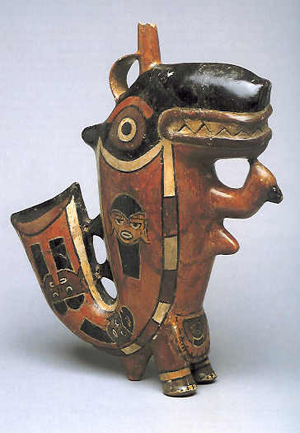
Killer whale (Orca)
Powerful nature gods were an essential element of the Nazca religious culture, which centered around agriculture.
Nazca Lines
The geoglyphs of Nazca, or “Nazca Lines,” are a series of geometric shapes, extended lines that run for miles, and large drawings of animal figures (some as large as a football field) constructed on the desert floor in the Nazca region. A large number of people over an extended period of time could have constructed the lines.
Researchers have demonstrated techniques to explore how this was done. By extending a rope between two posts and removing the red pebbles on the desert surface along the rope, the lines could have been constructed. The contrast of the red desert pebbles and the lighter earth beneath would make the lines visible from a high altitude. Due to the simplistic construction of the geoglyphs, regular amounts of rainfall would have easily eroded the drawings, but the dry desert environment has preserved the lines for hundreds of years. Several theories have been posited as to why the Nazca Lines exist, but the true meaning of the geoglyphs remains a mystery.
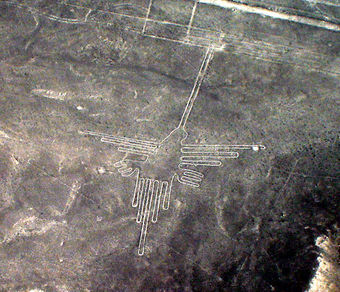
Nazca Lines
These Nazca lines, called The Hummingbird, are representative of the type of structures that remain.
Agriculture and Diet
Nazca subsistence was based largely on agriculture. Iconography on ceramics and excavated remains indicate that the Nazca people had a varied diet, including:
- Maize
- Squash
- Sweet potatoes
- Beans
- Manioc (also known as Yuca)
- Achira
- Small amounts of fish
- Peanuts
They also grew several non-food crops, such as cotton for textiles, coca, San Pedro cactus, and gourds. The latter were decorated to illustrate activities in daily life. The presence of coca is evident in pottery and artwork. The leaves of this plant were chewed and worked as a stimulant that suppressed hunger, pain, thirst, and fatigue. The hallucinogenic San Pedro cactus also appears on several polychrome pots and bowls showcasing its ceremonial significance.
In terms of animal resources, the Nazca made sacrifices of llamas and guinea pigs at Cahuachi. Llamas were also commonly exploited as pack animals, for their wool, and as a source of meat.
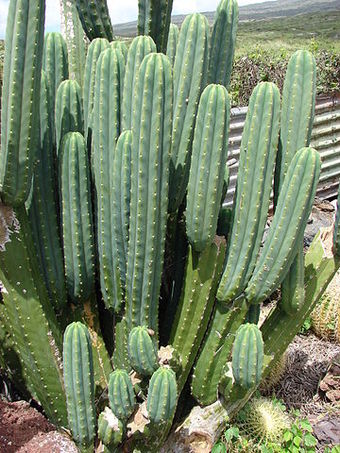
San Pedro cactus
This plant, Echinopsis pachanoi, has hallucinogenic properties, which shamans of the Nazca culture utilized in ceremonies.
Trephination and Cranial Manipulation
Trephination was a primitive skull surgery used by the Nazca that relieved pressure on the brain from battle wounds or for ritual purposes. It entails the removal of one or more sections of bone from the skull, while the person is still alive. Evidence of trephination has been seen through the analysis of excavated skulls. Some of the skulls show signs of healing, evidence that some individuals who underwent the procedure survived.
Elongated skulls, as a result of skull manipulation, were also seen in the excavations from Cahuachi. This effect was achieved by binding a cushion to an infant’s forehead and a board to the back of the head. Archaeologists can only speculate as to why this was done to some of the skulls. Several theories suggest skull manipulation created an ethnic identity, formed the individual into a social being, or may have illustrated social status.
Decline of the Nazca
Like the Moche, who lived along the arid northern coast of Peru during the same time period, it is thought that the Nazca may have been forced into decline by environmental changes. This is thought to have occurred when an El Niño triggered widespread and destructive flooding, leaving the civilization unstable by 750 CE. Evidence also suggests that the Nazca people may have exacerbated the effects of these floods by gradually cutting down Prosopis pallida trees to make room for maize and cotton agriculture. These trees play an extremely important role as an ecological keystone of this landscape, in particular preventing river and wind erosion. Gradual removal of trees would have exposed the landscape to the effects of climate perturbations such as El Niño, leading to erosion and leaving irrigation systems high and dry.
16.1.3: The Sicán
The Sicán culture inhabited what is now the north coast of Peru between about 750 and 1375 CE.
Learning Objective
Explain the unique aspects of the Sicán and what led to their downfall
Key Points
- In the Early Sicán period (750–900 CE) the Sicán began to establish trade and commerce.
- The Middle Sicán period (900–1100 CE) saw an explosion of culture and art, along with the development of extensive trading routes.
- Environmental changes caused unrest in the Late Sicán period (1100–1375), but the ultimate end to the Sicán came when they were conquered by the Chimú.
Key Terms
- tumbaga
-
A thin sheet of low-karat gold alloy, which was used to decorate symbolic metal vessels for lower elites.
- Sicán Precinct
-
The religious and cultural center of the Sicán culture.
- Sicán Deity
-
The central religious figure of the Middle Sicán period. This entity represented water, the ocean, and natural resources. It was also the social underpinning of the theocratic state.
The Sicán culture inhabited what is now the north coast of Peru between about 750 CE and 1375 CE. They succeeded the Moche culture, but there is still controversy among archeologists and anthropologists over whether the two are separate cultures.
Early Sicán Period
The Early Sicán period began around 750 CE and lasted until 900 CE. The lack of artifacts has limited the development of knowledge about this early period. Based on common themes, the Sicán were probably direct descendants of the Moche and developed their new culture during an unstable time in the region.
From remains found in archaeological locations, researchers have determined that this culture maintained commercial exchange with people from present-day Ecuador, Colombia, and Chile, and the eastern basin of the Marañón River.
The Early Sicán culture is known for the highly polished, black-finish ceramics found in the La Leche Valley. This black-finish ceramic style began in the Moche culture prior to the Early Sicán, and demonstrates the sharing of cultures in the region. Many of the ceramics were examples of a single spout, loop-handle bottle, featuring an anthropomorphic-avian (bird) face at the spout base. The face consisted of bulging eyes, a hooked beak or triangular projection instead of a nose, stylized ears, and no mouth. It appeared to be a predecessor to the related faces of the Sicán Deity and the Sicán Lord of the Middle Sicán culture.

Ceremonial mask
Peru, north coast, La Leche Valley, 900–1100 CE.
Aside from the shared ceramic styles, much of the Early Sicán defines a distinguishable culture. While the ceramic styles and iconography show some continuity with previous cultures, the changing iconography, ceramic themes, and funerary practices reflect a change in religious ideology and cosmology that expressed the Sicán culture.
Most importantly, the late Early Sicán period saw a major organizational and religious shift, by which the Sicán constructed monumental adobe structures, developed large-scale copper alloy smelting and metalworking, and developed the elaborate funerary tradition that would come to characterize the Middle Sicán. Such changes have been noted by researchers at sites in Batan Grande, including the Huaca del Pueblo site, dated to around 850–900 CE.
Middle Sicán Period
The Middle Sicán period lasted from 900 to 1100 CE. This is the period of the Sicán’s “cultural florescence,” and was marked by the emergence of various cultural innovations, some of which were unprecedented in the local area. The Sicán culture had a highly productive economy, clear social differentiation, and an influential religious ideology. This religious ideology served as the underpinning of the social hierarchy of the theocratic state.
The precious metal objects found in Middle Sicán sites reveal the unprecedented scale of their production and use, as well as the class hierarchy inherent in Sicán culture. Metal objects permeated all levels of society. Tumbaga, a thin sheet of low-karat gold alloy, was used to wrap ceramic vessels for the lower elites, while the upper elites had high-karat gold alloys. Common laborers had only arsenical copper objects.
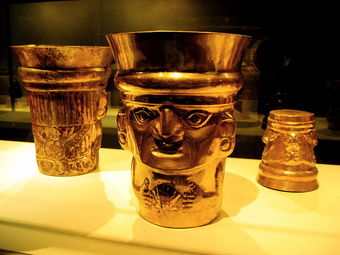
Gold beaker
A 9th—11th century gold beaker exemplary of Middle Sicán art and craftsmanship.
Funerary Practices of the Middle Sicán
Funerary practices at Huaca Loro reflected the social differentiation and hierarchy present in Sicán society. This social stratification is revealed in varying burial types and practices, along with accompanying grave goods. The most obvious difference in burial type based on social hierarchy was that commoners were buried in simple, shallow graves on the peripheries of the monumental mounds while the elite were buried in deep shaft tombs beneath monumental mounds. It was found that one’s social status was also a determinant of the burial position of the body—whether it was seated, extended, or flexed. Bodies of the high elite were always buried in the seated position, while commoners could be buried in a seated, extended, or flexed position.
Social stratification and hierarchy is also evidenced through the variation in quantity and quality of grave goods for different social classes. The elite East Tomb at Huaca Loro contained over a ton of diverse grave goods, over two-thirds of which were objects of arsenical bronze, tumbaga, silver and copper alloys, and high-karat gold alloys. Other grave goods of the elite included:
- Semi-precious stone objects
- Amber
- Feathers
- Textiles
- Imported shells (such as conus and spondylus)
- Shell beads
- Double spout bottles
All of these items required hours of labor and precious supplies, highlighting the power of the elite. On the other hand, commoners had significantly fewer grave goods of different types, made of less valuable materials. For example, commoner grave goods at Huaca Loro were usually restricted to single-spout bottles, utilitarian plain and/or paddle decorated pottery, and copper-arsenic objects, instead of the precious metal objects of the elite tombs.
Religious Cities and Elite Culture
The Sicán culture was characterized by the establishment of religious cities with monumental temples. The religious capital city and cultural center of the Middle Sicán is referenced as the Sicán Precinct, which is defined by a number of monumental rounds. The pyramidal monumental mounds were used as both burials sites for the elite and places of worship and ritual. The construction of these mounds required considerable material, manpower, and time, indicating the Sicán elite’s control and monopoly over the society’s resources.
None of the metalworking sites showed evidence of on-site mining of any materials. In addition, the spondylus shell, emeralds, feathers, and other minerals were imported to the area. Their materials came from mainly the Northern Andes, but could have also come from as far south as the Tiwanaku lands in the South Central Andes and as far east as the Marañón River, a major Amazon River tributary. The Sicán also could have controlled the transport methods in addition to the goods being traded. The breeding and herding of llamas on the north coast since the time of the Moche could have been utilized by the Sicán to provide caravans of llamas to transport the goods considerable distances.
Late Sicán Period
The Late Sicán period began around 1100 CE and ended with the Chimú conquest of the Lambayeque region around 1375 CE.
Around 1020 CE, a major drought lasting thirty years occurred at Sicán. At the time of the drought, the Sicán Deity, so closely tied to the ocean and water in general, was at the center of Sicán religion, and appeared in most major artistic motifs. The catastrophic changes in weather were thus linked to the Sicán Deity, mainly to the failure of the deity to mediate nature for the Sicán people. The Sicán ceremonies (and mounds on which they were performed) were supposed to ensure that there was an abundance of resources for the people. After thirty years of uncertainty in respect to nature, the temples that were the center of Middle Sicán religion and elite power were burned and abandoned, between 1050 and 1100 CE.
Perhaps the ancestor cult and aggrandizing of the elites caused too much resentment. Coupled with the drought that surely weakened agriculture in the area, the tolerance of the common population plummeted, forcing the removal of the political and religious leadership at Sicán.
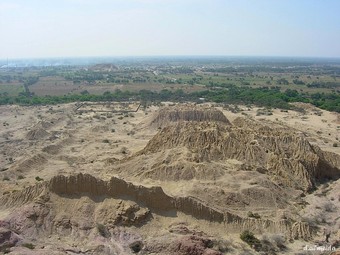
Religious mounds at Túcume
The last capital of the Sicán culture was located just south of the La Leche River, where they built twenty-six new religious mounds.
The Sicán then built a new capital at Túcume, also known as Purgatorio by local people today, where they thrived for another 250 years. The Sicán were able to build twenty-six ceremonial mounds in this new capital in that time period. However, in 1375, the Chimú conquered the area, marking the end of the Sicán era.
16.1.4: Chimú
The Chimú lived in modern-day Peru from 900–1470 CE.
Learning Objective
Discuss distinguishing aspects of Chimú religion, craftsmanship, and agriculture
Key Points
- The Chimú expanded to cover a vast area and include many different ethnic groups along the northern coast of modern-day Peru.
- Chimú artisans made notable multi-colored textiles and monochromatic pottery and metalwork.
- In 1470, the Chimú were conquered by the Inca.
- The Chimú worshipped the Moon as the essential deity of fertility, good weather, and bountiful crops.
Key Terms
- Chan Chan
-
The capital of the Chimú culture. It is in modern-day Peru.
- Chimor
-
The long swath of land along the northern coast of Peru that was ruled by the Chimú elite.
- ciudadela
-
Any one of a number of walled cities in the Chimú capital of Chan Chan where elites consolidated power and artisans lived in organized groups to make prestige goods.
The Chimú were a culture that lasted from approximately 900 CE until 1470 CE along the northern coast of modern-day Peru, centered in the city of Chan Chan. This is not to be confused with the Early Chimú, a related group also known as the Moche that lived in the region until about 800 CE.
The Inca ruler Tupac Inca Yupanqui led a campaign that conquered the Chimú around 1470 CE. This was just fifty years before the arrival of the Spanish in the region. Consequently, Spanish chroniclers were able to record accounts of Chimú culture from individuals who had lived before the Inca conquest. Similarly, archaeological evidence suggests Chimor, the large coastal swath of land inhabited by Chimú culture, grew out of the remnants of Moche culture. Early Chimú ceramics in a high-sheen black, along with detailed and intricate precious metalworking, shared many of the same aspects as Moche craftsmanship.
The mature Chimú culture developed in roughly the same territory where the Moche had existed centuries before, which made the Chimú another coastal culture. It was developed in the Moche Valley south of present-day Lima, northeast of Huarmey, and grew to include central present-day Trujillo, where the bureaucratic and artisanal capital of Chan Chan developed.
The Chimú expansion also incorporated many different ethnic groups, including the Sicán culture, which lasted independently until 1375. At its peak, the Chimú advanced to the limits of the desert coast, to the Jequetepeque Valley in the north, and Carabayallo in the south. Their expansion southward was stopped by the military power of the great valley of Lima.
Agriculture and Bureaucracy
The Chimú expanded and gained power over their 500-year growth through intensive farming techniques and hydraulic works, which joined valleys to form complexes. A few of these landmark agricultural techniques included the following:
- Huachaques: These sunken farms included the removal of the top layer of earth and allowed farmers to work the moist, sandy soil underneath.
- Walk-in wells, similar to those of the Nazca, were developed to draw water.
- Large reservoirs were developed to retain water from river systems in this arid climate where water was an essential resource.
These systematic changes increased the productivity of the land, which multiplied Chimú wealth and likely contributed to the formation of a bureaucratic, hierarchical system.
The Chimú cultivated beans, sweet potatoes, papayas, and cotton with their reservoir and irrigation systems. This focus on large-scale irrigation persisted until the Late Intermediate period. At this point, there was a shift to a more specialized system that focused on importing and redistributing resources from satellite communities. There appears to have been a complex network of sites that provided goods and services for Chimú subsistence.
Many of these satellite areas produced commodities that the Chimú population based in the capital of Chan Chan could not. Some sites relied on marine resources, such as fish and precious shells. However, after the advent of agriculture, more sites developed further inland, where marine resources were harder to attain. These inland communities began raising llamas as a supplemental source of meat, but by the Late Intermediate period and Late Horizon, inland sites started to rely on llamas as an essential transportation and food resource.
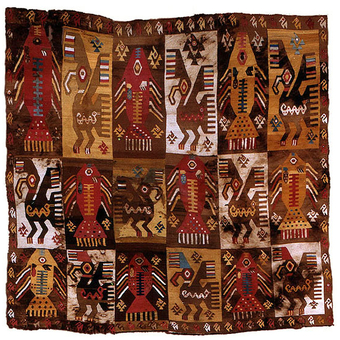
Chimú mantle
The Chimú are known for their artisanal works, such as this mantle spun of multiple colored fibers sometime from 1000 to 1476 CE.
Artisans
The capital of Chan Chan likely developed a complex bureaucracy due to the elite’s controlled access to information. This bureaucratic center imported raw materials from across Chimor, which were then processed into prestige goods by highly skilled artisans. The majority of the citizens in each ciudadela (walled cities in the capital of Chan Chan) were artisans. In the late Chimú, about 12,000 artisans lived and worked in Chan Chan alone. Artisans played an essential role in Chimú culture:
- They engaged in fishing, agriculture, craft work, and trade.
- Artisans were forbidden to change their profession, and were grouped in the ciudadela according to their area of specialization.
- Archeologists have noted a dramatic increase in Chimú craft production over time, and they believe that artisans may have been brought to Chan Chan from other areas taken as a result of Chimú conquest.
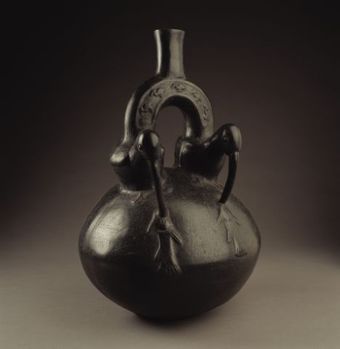
Chimú pottery
Chimú pottery is distinctly monochromatic and bears a striking resemblance to Moche pottery.
Pottery and Textiles
Though their textiles were multicolored, their pottery and metalwork are known for being monochromatic. The pottery is often in the shape of a creature, or has a human figure sitting or standing on a cuboid bottle. The shiny black finish of most Chimú pottery was achieved by firing the pottery at high temperatures in a closed kiln, which prevented oxygen from reacting with the clay.
Deities
The Chimú worshipped the Moon (Si) and considered it the greatest and most powerful of the deities. It was believed to be more powerful than the Sun, as it appeared by night and day, and was deeply linked with patterns in weather, fertility, and the growth of crops. Sacrifices of spondylus shells and other precious items were made to the Moon. Devotees sacrificed their own children on piles of colored cotton with offerings of fruit and chicha. They believed the sacrificed children, normally around the age of five, would become deified.
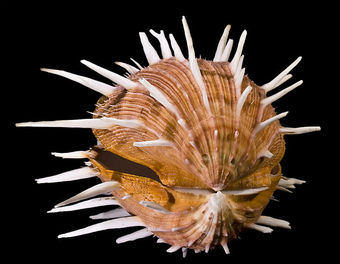
Spondylus
Spondylus shells were used as a currency and as offerings to the deities.
Animals and birds were also sacrificed to the Moon in order to appease this powerful entity. Two of the stars of Orion’s Belt were considered to be the emissaries of the Moon. The constellation Fur (the Pleiades) was also used to calculate the year and was believed to watch over the crops.
The Sun was associated with stones called alaec-pong (cacique stone). These stones were believed to be ancestors of the people in the areas they were found. They were also considered to be sons of the Sun deity. Along with the Sun, the Sea (Ni) was also a very important deity, and sacrifices of white maize flour, red ochre, and other precious items were made to it. Prayers for fish and protection against drowning were also offered. Shrines (called huacas) developed in each district across Chimor, dedicated to an associated legend, deity, or cult of belief, depending on the region.
The Fall of the Chimú
The end of the Chimú was brought about in the 1470s. They were conquered by the Inca ruler Tupac Inca Yupanqui, who led a fierce and well organized army northward. The Chimú were considered the last substantial rival culture standing in the way of the Inca conquest of the region.
16.2: The Inca
16.2.1: The Inca People
The Inca Empire was the largest of the pre-Columbian mesoamerican empires.
Learning Objective
Explain Inca agriculture, clothing, commodities, and architecture, and how these elements shaped their complex society.
Key Points
- Centered in Cusco, the Inca Empire extended from modern-day Chile to modern-day Colombia.
- Inca society was sophisticated, and boasted around seventy different crops across the empire’s various climates.
- The Inca considered finely woven textiles to be an essential commodity, and spun various grades of cloth from llama and vicuña wool.
Key Terms
- quinoa
-
This grain crop produces edible seeds that are high in protein and played an essential role in the Inca diet.
- Machu Picchu
-
This Inca citadel was probably built for the emperor Pachacutec around 1450 CE in the Andes at a height of around 8,000 feet above sea level using dry stone masonry.
- awaska
-
A lower-grade textile woven from llama wool and used for everyday household chores and cleaning.
The Inca Empire, or Inka Empire, was the largest empire in pre-Columbian America. The civilization emerged in the 13th century and lasted until it was conquered by the Spanish in 1572. The administrative, political, and military center of the empire was located in Cusco (also spelled Cuzco) in modern-day Peru. From 1438 to 1533, the Incas used a variety of methods, from conquest to peaceful assimilation, to incorporate a large portion of western South America. Beginning with the rule of Pachacuti-Cusi Yupanqui, the Inca expanded their borders to include large parts of modern Ecuador, Peru, western and south-central Bolivia, northwest Argentina, north and north-central Chile, and southern Colombia. This vast territory was known in Quechua (the language of the Inca Empire) as Tawantin Suyu, or the Four Regions, which met in the capital of Cusco.
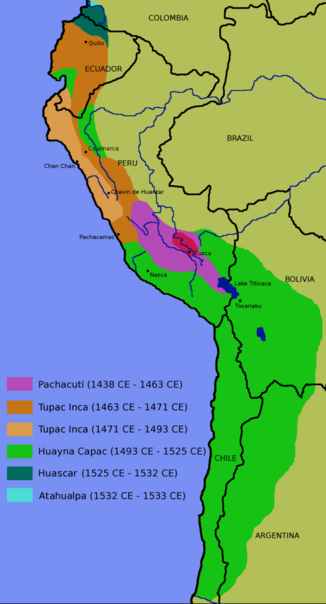
Inca Empire
From 1438 to 1533, the Inca Empire expanded significantly.
Architecture and Masonry
Architecture illustrates the sophistication and technical skill typical of the Inca Empire. The main example of this resilient art form was the capital city of Cusco, which drew together the Four Regions. The Inca used a mortarless construction technique, called dry stone wall, that fit stones together so well that a knife could not be fitted through the stonework. This was a process first used on a large scale by the Pucara (c. 300 BCE–300 CE) peoples to the south in Lake Titicaca, and later in the great city of Tiwanaku (c. 400–1100 CE) in present-day Bolivia. The rocks used in construction were sculpted to fit together exactly by repeatedly lowering one rock onto another and carving away any sections on the lower rock where there was compression or the pieces did not fit exactly. The tight fit and the concavity on the lower rocks made them extraordinarily stable.
Machu Picchu was built around 1450, at the height of the Inca Empire. It is a rare example of this architectural building technique and remains in remarkable condition after many centuries. The construction of Machu Picchu appears to date from the period of the two great Inca emperors, Pachacutec Inca Yupanqui (1438–1471) and Tupac Inca Yupanqui (1472–1493), and was probably built as a temple for the emperor Pachacutec. Machu Picchu was abandoned just over 100 years later, in 1572, as a belated result of the Spanish Conquest, possibly related to smallpox.

Machu Picchu
This impressive mountain-top temple was built around 1450 CE using dry stone wall.
Textiles, Ceramics, and Metalwork
Textiles were one of the most precious commodities of the Inca culture and denoted a person’s social status, and often their profession. The brightly colored patterns on a wool tunic represented various positions and achievements. For example, a black-and-white checkerboard pattern topped with a pink triangle denoted a soldier. Because textiles were so specific to a person’s class and employment, citizens could not change their wardrobe without the express permission of the government. Textiles were also manufactured that could only be used for certain tasks or social arenas. A rougher textile, spun from llama wool and called awaska, was used for everyday household chores. On the other hand, a fine-spun, very soft cloth made from vicuña wool could only be used in religious ceremonies.
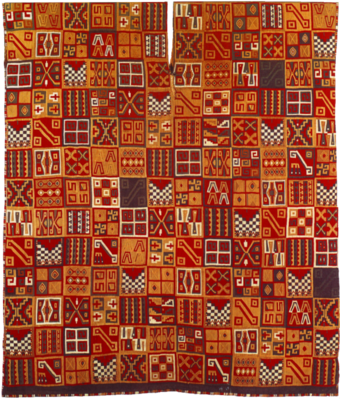
Inca tunic
The complex patterns woven into most Inca textiles and made into tunics, like this one, denoted a person’s position in society.
Although textiles were considered the most precious commodity in Inca culture, Incas also considered ceramics and metalwork essential commodities of the economy and class system. Incan pottery was distinctive and normally had a spherical body with a cone-shaped base. The pottery would also include curved handles and often featured animal heads, such as jaguars or birds. These ceramics were painted in bright colors, such as orange, red, black, and yellow.
The Inca also required every province to mine for precious metals like tin, silver, gold, and copper. The intricate metalwork of the Inca was heavily influenced by the Chimú culture, which was conquered and absorbed into the Inca culture around 1470. This metalwork included detailed friezes and patterns inlaid into the metal. Fine silver and gold were made into intricate decorative pieces for the emperors and elites based on these Chimú metallurgy traditions, and often included animal motifs with butterflies, jaguars, and llamas etched into the metal. Skilled metallurgists also transformed bronze and copper into farming implements, blades, axes, and pins for everyday activities.
Agriculture and Diet
The Inca culture boasted a wide variety of crops, numbering around seventy different strains in total, making it one of the most diverse crop cultures in the world. Some of these flavorful vegetables and grains included:
- Potatoes
- Sweet potatoes
- Maize
- Chili peppers
- Cotton
- Tomatoes
- Peanuts
- Oca
- Quinoa
- Amaranth
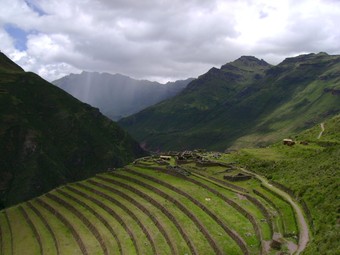
Terraced farmland in Peru
Terraces allowed Inca farmers to utilize the mountainous terrain and grow around seventy different crops.
These crops were grown in the high-altitude Andes by building terraced farms that allowed farmers to utilize the mineral-rich mountain soil. The quick change in altitude on these mountain farms also utilized the micro-climates of each terrace to grow a wider range of crops. The Inca also produced bounties in the Amazon rainforest and along the more arid coastline of modern-day Peru.
Alongside vegetables, the Inca supplemented their diet with fish, guinea pigs, camelid meat, and wild fowl. They also fermented maize, or corn, to create the alcoholic beverage chicha.
16.2.2: Administration of the Inca Empire
The Inca Empire utilized complex road systems, recording tools, and a hierarchical rule of law to oversee the administration of its vast population.
Learning Objective
Understand the importance of the governing bodies, road system, recording tools, and social hierarchy of the Inca Empire
Key Points
- The Inca Empire utilized a complex road system with about 25,000 miles of roads that relayed messages and goods throughout the society.
- Inca administrators used brightly colored knotted strings called quipus to keep precise records of labor, taxes, and goods.
- The Inca had no written legal code, but relied on magistrates and inspectors to keep people in line with established social customs.
Key Terms
- quipus
-
Brightly colored knotted strings that recorded numerical information, such as taxes, goods, and labor, using the base number of 10 to record data in knots.
- suyus
-
Distinct districts of the Inca Empire that all reported back to the capital of Cusco. There were four major districts during the height of the empire.
- ayllu
-
A clan-like family unit based upon a common ancestor.
Hierarchy
The
Inca Empire was a hierarchical system with the emperor, or Inca Sapa,
ruling over the rest of society. A number of religious officials and magistrates oversaw the
administration of the empire directly below the emperor. Kurakas were magistrates that served as the head of an ayllu, or clan-like family unit based on a common ancestor.
These leaders mitigated between the spiritual and physical worlds.
They also collected taxes, oversaw the day-to-day administration of
the empire in their regions, and even chose brides for men in their
communities. Some of the privileges kurakas enjoyed included exemption from taxation, the right to ride in a litter, and the
freedom to practice polygamy.
Society
was broken into two distinct parts. One segment was comprised of the common people, including those
cultures that had been subsumed by the Inca Empire. The second group was made up of the elite of
the empire, including the emperor and the kurakas, along with various
other dignitaries and blood relations. Education was vocationally based for commoners, while
the elite received a formal spiritual education.
There
was no codified legal system for people that broke with the
cultural and social norms. Local inspectors called okoyrikoq, or
“he who sees all,” reported back to the capital and the emperor
and made immediate decisions regarding punishment in cases where customs were not honored. Many
times these local inspectors were blood relatives of the emperor.
Road System
The Inca civilization was able to keep populations in line,
collect taxes efficiently, and move goods, messages, and military
resources across such a varied landscape because of the complex road
system. Measuring about 24,800 miles long, this road system connected
the the regions of the empire and was the most complex
and lengthy road system in South America at the time. Two main routes
connected the north and the south of the empire, with many smaller
branches extending to outposts to the east and west. The roads varied
in width and style because often the Inca leaders utilized roads that
already existed to create this powerful network. Common people
could not use these official roads unless they were given permission
by the government.
These
roads were used for relaying messages by way of chasqui, or human runners, who could run up to 150 miles a day with messages for
officials. Llamas and alpacas were also used to
distribute goods throughout the empire and ease trade relations.
The roads also had a ritual purpose because they allowed the highest leaders of the Inca Empire to
ascend into the Andes to perform religious rituals in sacred spaces,
such as Machu Picchu.
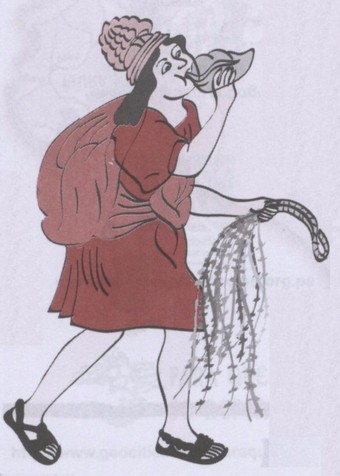
Chasqui carrying a quipu on official state business
Chasquis were highly agile long-distance runners who used the complex road systems to relay messages and goods between cities.
Record Keeping
The
Inca utilized a complex recording system to keep track of the administration of the empire. Quipus (also spelled khipus) were colorful bunches of knotted strings that recorded census data, taxes,
calendrical information, military organization, and accounting
information. These “talking knots” could contain anything from a
few threads to around 2,000, and used the base number of 10 to record
information in complex variations of knots and spaces.
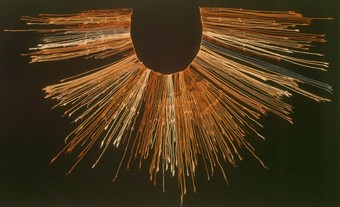
Inca quipu
These complex recording devices allowed officials to keep track of taxes, labor, and goods in a precise fashion.
The
Spanish burned the vast majority of existing quipus when they arrived
in South America. However, there is some evidence to suggest that
these tools were also used to record stories and language for
posterity, and were not only numerical recording devices.
Trade
and Economics
Trade
and the movement of goods fed into what is called the vertical
archipelago. This system meant that all goods produced within the
empire were immediately property of the ruling elites. These elites,
such as the emperor and governors, then redistributed resources
across the empire as they saw fit.
Taxes
and goods were collected from four distinct suyus, or
districts, and sent directly to the ruling emperor in Cusco. This highly organized system was most likely
perfected under the emperor Pachacuti around 1460.
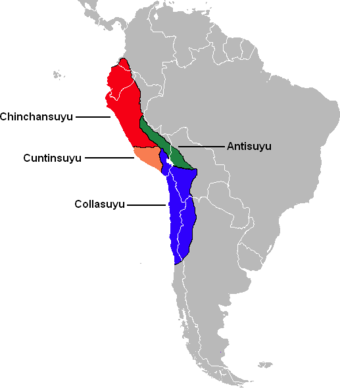
The Four suyus of the Inca Empire
The economic system linked together four large suyus, or districts, that all reported back to the capital of Cusco.
This
system also required a minimum quota of manual labor from the general
population. This form of labor taxation was called mita. The
populations of each district were expected to contribute to the
wealth of the empire by mining, farming, or doing other manual labor
that would benefit the entire empire. Precious metals, textiles, and
crops were collected and redistributed using the the road system that
snaked across the land, from the ocean to the Andes.
16.2.3: Religion in the Inca Empire
The Inca Empire worshipped the Sun god Inti, and expanded its hold on outlying areas by incorporating other deities into the religious system.
Learning Objective
Learn about the forms of worship of the Sun god Inti, the religious hierarchy, and the cultural assimilation of outlying clans in the Inca Empire
Key Points
- The Inca rulers worshipped the Sun god Inti and built the central temple, Qurikancha, in Cusco.
- The Inca elite incorporated the varied populations into the empire by allowing the worship of other deities.
- Various festivals celebrated the different aspects of the Sun. The most important of these festivals was Inti Raymi, which focused on abundance.
Key Terms
- Pachamama
-
The Earth goddess worshipped by many clans in outlying areas of the Inca Empire. Inca rulers enforced a religious system that favored Inti, but they incorporated the Earth goddess as a lesser deity.
- Inti
-
The central Sun god the Inca worshipped. He represented abundance, harvests, and fertility, and was considered more important than any other deity worshipped in the region.
- Inti Raymi
-
The most important religious festival of the Inca year. It means “Sun Festival” and occurred close to the winter solstice, which happens in June in South America.
The Inca religious system utilized oral traditions to pass down the mythology of their Sun god, Inti. This benevolent male deity was often represented as a gold disk with large rays and a human face. Golden disks were commonly displayed at temples across the Inca Empire and were also associated with the ruling emperor, who was supposed to be a direct descendent of Inti, and divinely powerful. Inti was also associated with the growth of crops and material abundance, especially in the high Andes, where the Inca centered their power.
Some myths state that this benevolent entity, along with Mama Killa, the Moon goddess, had children. Inti ordered these children, named Manco Cápac and Mama Ocllo, to descend from the sky and onto Earth with a divine golden wedge. This wedge penetrated the earth, and they built the capital of Cusco and civilization on that very spot.
Inti Worship
Royalty were considered to be direct descendants of Inti and, therefore, able to
act as intermediaries between the physical and spiritual realms. The
high priest of Inti was called the Willaq
Umu.
He was often the brother or a direct blood relation of the Sapa Inca,
or emperor, and was the second most powerful person in the empire.
The royal family oversaw the collection of goods, spiritual
festivals, and the worship of Inti. Power consolidated around the
cult of the Sun, and scholars suggest that the emperor Pachacuti
expanded this Sun cult to garner greater power in the 15th
century.
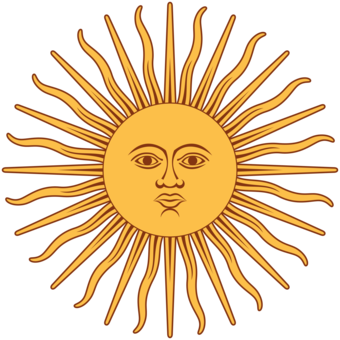
An illustrated representation of the Sun god Inti
This image of Inti appears at the center of Argentina’s modern-day flag.
Conquered provinces
were expected to dedicate a third of their resources, such as herds and crops, directly to the
worship of Inti. Each province also had a temple with male and
female priests worshipping the Inti cult. Becoming a priest was
considered one of the most honorable positions in society. Female
priests were called mamakuna,
or “the chosen women,” and they wove special cloth and brewed
chicha for religious festivals.
The main temple in the
Inca Empire, called Qurikancha, was built in Cusco. The temple housed
the bodies of deceased emperors and also contained a vast array of
physical representations of Inti, many of which were removed or destroyed when the Spanish arrived. Qurikancha was also the main site
of the religious festival Inti Raymi, which means “Sun Festival.”
It was considered the most important festival of the year, and is
still celebrated on the winter solstice in Cusco. It represents
the mythical origin of the Inca and the hope for good crops in the
coming year as the winter sun returns from darkness.
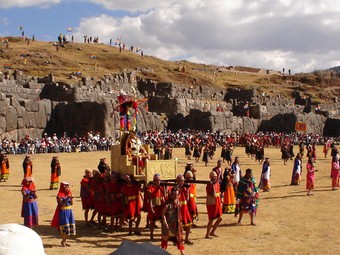
The festival of Inti Raymi
This festival is celebrated in late June in the capital of Cusco every year. Thousands of visitors arrive to see the procession and rituals.
Religious Expansion
Religious life was
centered in the Andes near Cusco, but as the Inca Empire expanded
its sphere of influence, they had to incorporate a wide array of
religious customs and traditions to avoid outright revolt. Ayllus, or family clans, often
worshipped very localized entities and gods. The ruling Inca often
incorporated these deities into the Inti cosmos. For example,
Pachamama, the Earth goddess, was a long-worshipped deity before the
Inca Empire. She was incorporated into Inca culture as a lower divine entity.
Similarly, the Chimú along the northern coast of Peru worshipped the Moon, rather than the Sun, probably due to the hot, arid climate and
their proximity to the ocean. The Inca also incorporated the Moon
into their religious myths and practices in the form of Mama Killa.
Sacrifice and the
Afterlife
The
Inca believed in reincarnation. Death was a passage to the next world that was full of difficulties. The spirit of the
dead, camaquen, would
need to follow a long dark road. The trip required the assistance of a
black dog that was able to see in the dark. Most Incas
imagined the after world to be very similar to the Euro-American
notion of heaven, with flower-covered fields and snow-capped
mountains. It was important for the Inca to ensure they did not die
as a result of burning or that the body of the deceased did not
become incinerated. This is because of the underlying belief that a
vital force would disappear and this would threaten their passage to the after
world. Those who obeyed the Inca moral code (do not steal, do not
lie, do not be lazy) went to live in the “Sun’s warmth”
while others spent their eternal days “in the cold earth.”
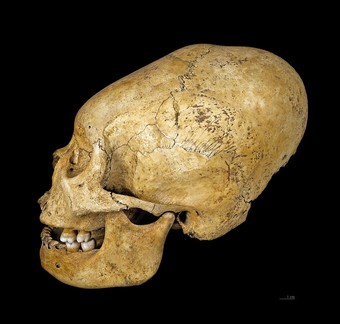
Skull showing signs of artificial cranial deformation
Although this skull predates the Inca Empire, and is from the Nazca culture, Inca elites would reshape infants’ skulls in a similar manner to illustrate a higher class status.
Human
sacrifice has been exaggerated by myth, but it did play a role in Inca religious practices. As many as 4,000 servants, court officials,
favorites, and concubines were killed upon the death of the Inca
Huayna Capac in 1527, for example. The Incas also performed child
sacrifices during or after important events, such as the death of the
Sapa Inca or during a famine. These sacrifices were known
as capacocha.
The Inca also
practiced cranial deformation. They achieved this by wrapping tight
cloth straps around the heads of newborns in order to alter the shape
of their soft skulls into a more conical form; this cranial
deformation distinguished social classes of the
communities, with only the nobility having it.
16.2.4: The Spanish Conquest
The Inca Empire already faced instability due to the Inca Civil War, European diseases, and internal revolt when explorer Francisco Pizarro began the conquest of Inca territory.
Learning Objective
Learn about the contributing factors that allowed the Spanish explorers to overpower the Inca Empire and establish control of the region
Key Points
- The Inca War of Succession began after the emperor Huayna Capac died around 1528 and his two sons both wanted to seize power.
- Internal instability allowed Francisco Pizarro and his men to find allies within the Inca Empire.
- Spanish forces ousted the last Inca holdout of Vilcabamba in 1572 and enforced a harsh rule of law on the local population.
Key Terms
- mita
-
A form of labor tax that required one person from each family to work in the mines. The Spanish enforced this heavy labor tax once they gained control of the region.
- Viceroyalty of Peru
-
The Spanish forces gave the newly seized Inca region this title and started to collect taxes and labor from the local people.
- Inca Civil War
-
This internal dispute started around 1528 between two sons of the deceased emperor who both wanted control, causing instability in the Inca Empire.
Spanish Arrival
The Spanish explorer Francisco Pizarro,
along with a small military retinue, landed on
South American soil around 1526. The Spanish recognized the wealth and
abundance that could be had in this territory; at this point the Inca Empire
was at its largest, measuring around 690,000 square miles. In 1528 Pizarro went back to Spain to ask for the official blessing of the Spanish
crown to the conquer the area and become governor. He returned with
his blessings around 1529 and began the official takeover of the
region.
Inca Civil War
Although Pizarro had a small force
behind him, many problems within the Inca Empire worked to his
advantage between 1528 and 1533. Foremost
among these was the Inca Civil War, which is also known as the War
of Succession or the War of Two Brothers. It began to brew just
one year after Pizarro first landed in the region. Around 1528, the
ruling Inca emperor, Huayna
Capac, and his designated heir, Ninan Cuyochic, died of disease. It
was most likely smallpox, which had quickly traveled down to South
America after the arrival of Spanish explorers in Central America.
Brothers Huascar and Atahualpa, two sons of the emperor Huayna Capac, both wanted to rule after their father’s death.
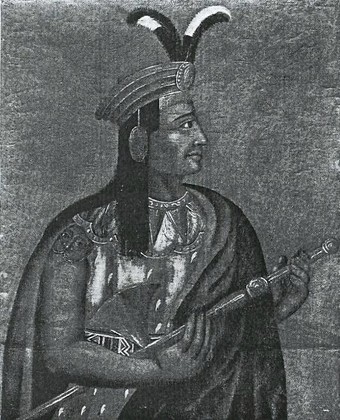
Inca Emperor Atahualpa
Although Atahualpa successfully won the Inca Civil War and ruled as emperor, he was soon captured by the Spanish and killed in 1533.
Initially, Huascar captured the throne
in Cusco, claiming legitimacy. However, Atahualpa had a keen military
mind and close relations with the military generals at the time, and
proved to be the deadlier force. Between 1529 and 1532 the two
brothers’ armies waged warfare, with one or the other gaining a
stronger foothold for a time. Atahualpa initially garnered favor with
northern allies and built a new capital for his forces in Quito. By
1532, Atahualpa had overpowered his brother’s forces via intrigue
and merciless violence, scaring many local populations away from standing up to his
power. This civil war left the population in a precarious position by
the time it ended.
Spanish Colonization
Around the same time that Atahualpa seized
the throne in 1532, Pizarro returned to Peru with blessings from the
Spanish crown. The Spanish forces went to meet with Atahualpa and
demanded he take up the “true faith” (Catholicism) and the yoke of
Charles I of Spain. Because of the language barrier, the Inca rulers probably did not understand much
of these demands, and the meeting quickly escalated to the Battle of
Cajamarca. This clash left thousands of native people dead. The Spanish also captured Atahualpa and kept him hostage,
demanding ransoms of silver and gold. They also insisted that
Atahualpa agree to be baptized. Although the Inca ruler was mostly
cooperative in captivity, and was finally baptized, the Spanish killed him on August 29, 1533,
essentially ending the potential for larger Inca attacks on Spanish
forces.
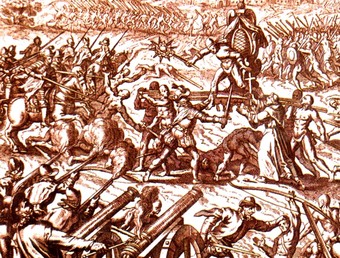
An engraved representation of the Battle of Cajamarca
This battle began in 1532, leaving thousands of native people dead and ending with the capture of Atahualpa.
Even though the Inca Civl War made
it easier for the Spanish armies to gain control initially, many
other contributing factors brought about the demise of Inca rule and
the crumbling of local populations. As scholar Jared Diamond points
out, the Inca Empire was already facing threats:
- Local unrest in the provinces after
years of paying tribute to the Inca elite created immediate allies
for the Spanish against the Inca rulers. - Demanding terrain throughout the empire
made it even more difficult to keep a handle on populations and goods
as the empire expanded. - Diseases that the population had
never been exposed to, such as smallpox, diphtheria, typhus, measles,
and influenza, devastated large swaths of the population within fifty years. - Superior Spanish military gear, including
armor, horses, and weapons, overpowered the siege warfare more common
in the Inca Empire.
The Last Incas
After Atahualpa died and the
Spanish seized control, they placed Atahualpa’s brother Manco Inca
Yupanqui in charge of Cusco as a puppet ruler while they tried to
reign in the north. After a failed attempt to recapture the city from
greater Spanish rule during this time, Manco retreated to Vilcabamba
and built the last stronghold of the Inca. The Inca continued to
revolt against totalitarian Spanish rule until the year 1572. In that
year the Spanish conquered Vilcabamba and killed the last Inca
emperor, Tupac Amaru, after a summary trial.
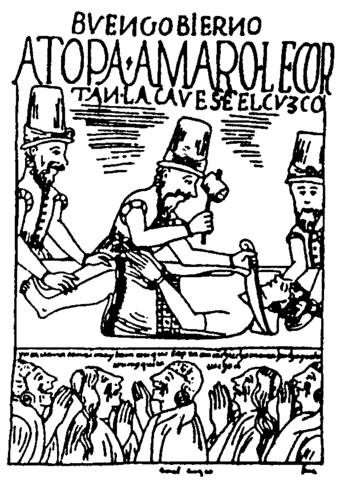
An image of the Spanish executing Tupac Amaru
The last Inca ruler, Tupac Amaru, was killed by Spanish forces in 1572, effectively ending any potential for an Inca uprising.
Spanish Rule
The Spanish named this vast region the
Viceroyalty of Peru and set up a Spanish system of rule, which
effectively suppressed any type of uprising from local communities.
The Spanish system destroyed many of
the Inca traditions and ways of life in a matter of years. Their
finely honed agricultural system, which utilized tiered fields in the
mountains, was completely disbanded. The Spanish also enforced heavy
manual labor taxes, called mita, on the local populations. In
general, this meant that every family had to offer up one person to
work in the highly dangerous gold and silver mines. If that family
member died, which was common, the family had to replace the fallen
laborer. The Spanish also enforced heavy taxes on agriculture, metals, and
other fine goods. The population continued to suffer heavy
losses due to disease as Spanish rule settled into place.
16.3: Early Civilizations of Mexico and Mesoamerica
16.3.1: The Olmec
The Olmec were the first major civilization in Mexico, lasting from approximately 1500—400 BCE.
Learning Objective
Give an account of the society, trade, art, and religion of the Olmec
Key Points
- The Olmec lived in south-central Mexico, with their center in La Venta in Tabasco.
- Little is known about Olmec religion, though scholars believe there were eight main deities.
- People lived in small agricultural villages outside of urban centers, which were mainly for ceremonial use.
- The decline of the Olmec population from 400—350 BCE may have been due to environmental changes.
Key Terms
- La Venta
-
The main city of the Olmec civilization.
- Mesoamerican ballgame
-
An ancient ritual sport that involved keeping a rubber ball in play in designated courts. It most likely originated in the Olmec culture.
- Olmec colossal heads
-
Basalt sculptures of human faces wearing large helmeted headdresses that stand up to 3.4 meters high. These sculptures most likely represent important rulers.
The Olmec were the first major civilization in Mexico. They lived in the tropical lowlands of south-central Mexico, in the present-day states of Veracruz and Tabasco, and had their center in the city of La Venta.
The Olmec flourished during Mesoamerica’s formative period, dating roughly from as early as 1500 BCE to about 400 BCE. Pre-Olmec cultures had flourished in the area since about 2500 BCE, but by 1600–1500 BCE, Early Olmec culture had emerged. They were the first Mesoamerican civilization and laid many of the foundations for the civilizations that followed, such as the Maya. Judging from the available archeological evidence it is likely that they originated the Mesoamerican ballgame and possible that they practiced ritual bloodletting.
The Gulf of Mexico’s lowlands are generally considered the birthplace of the Olmec culture, and remained the heartland of this civilization during its existence. This area is characterized by swampy lowlands punctuated by low hills, ridges, and volcanoes. The Tuxtlas Mountains rise sharply in the north, along the Gulf of Mexico’s Bay of Campeche. Here the Olmec constructed permanent city-temple complexes at San Lorenzo Tenochtitlán, La Venta, Tres Zapotes, and Laguna de los Cerros. San Lorenzo remained the Olmec capital up until about 900 BCE, when the central city became La Venta, which remained functional until the demise of the Olmec around 400 BCE. Possible river or weather changes caused this movement to occur.
Trade and Village Life
There are no written records of Olmec commerce, beliefs, or customs, but from the archeological evidence it appears they were not economically confined. In fact, Olmec artifacts have been found across Mesoamerica, indicating that there were extensive interregional trade routes. The Olmec period saw a significant increase in the length of trade routes, the variety of goods, and the sources of traded items.
Trading helped the Olmec build their urban centers of San Lorenzo and La Venta. However, these cities were used predominantly for ceremonial purposes and elite activity; most people lived in small villages. Individual homes had a lean-to and a storage pit nearby. They also likely had gardens, in which the Olmec would grow medicinal herbs and small crops, like sunflowers.
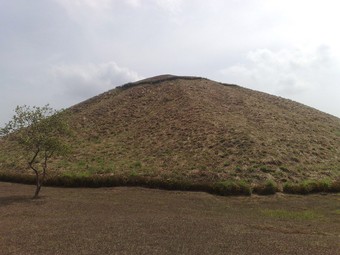
The Great Pyramid in La Venta, Tabasco
Remains of the last capital of the Olmec society, La Venta, include this religious site where elites most likely performed rituals.
Most agriculture took place outside of the villages in fields cleared using slash-and-burn techniques. The Olmec likely grew crops such as:
- Maize
- Beans
- Squash
- Manioc
- Sweet potatoes
- Cotton
Religion
Unfortunately, there is no surviving direct account of Olmec beliefs, but their notable artwork provide clues about their life and religion.
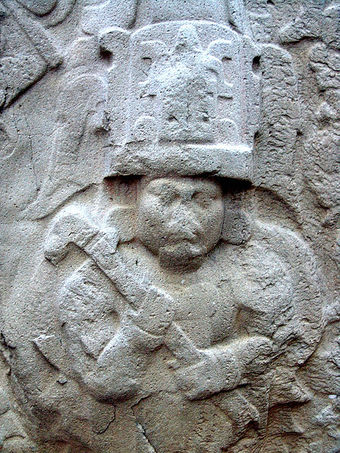
Olmec king
Surviving art, like this relief of a king or chief found in La Venta, help provide clues about how Olmec society functioned.
There were eight different androgynous Olmec deities, each with its own distinct characteristics. For example, the Bird Monster was depicted as a harpy eagle associated with rulership. The Olmec Dragon was shown with flame eyebrows, a bulbous nose, and bifurcated tongue. These gods were believed to provide the rulers a mandate to lead. Deities often represented a natural element and included:
- The Maize deity
- The Rain Spirit or Were-Jaguar
- The Fish or Shark Monster
Religious activities regarding these deities probably included the elite rulers, shamans, and possibly a priest class making offerings at religious sites in La Venta and San Lorenzo.
Art
The Olmec culture was defined and unified by a specific art style, and this continues to be the hallmark of the culture. Wrought in a large number of media—jade, clay, basalt, and greenstone, among others—much Olmec art, such as The Wrestler, is surprisingly naturalistic. Other art expresses fantastic anthropomorphic creatures, often highly stylized, using an iconography reflective of a religious meaning. Common motifs include downturned mouths and a cleft head, both of which are seen in representations of were-jaguars and the rain deity.
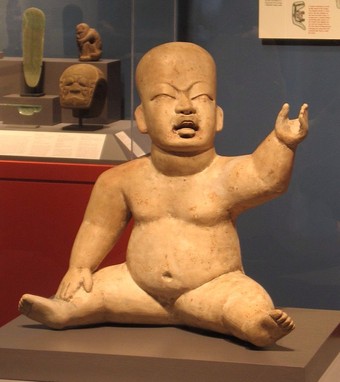
Olmec hollow baby figurine
Realistic ceramic objects, such as this portrayal of an infant, illustrate the highly skilled artistic style of the Olmec culture.
Olmec Colossal Heads
The most striking art left behind by this culture are the Olmec colossal heads. Seventeen monumental stone representations of human heads sculpted from large basalt boulders have been unearthed in the region to date. The heads date from at least before 900 BCE and are a distinctive feature of the Olmec civilization. All portray mature men with fleshy cheeks, flat noses, and slightly crossed eyes. However, none of the heads are alike, and each boasts a unique headdress, which suggests they represent specific individuals.
The boulders were brought from the Sierra de los Tuxtlas mountains of Veracruz. Given that the extremely large slabs of stone used in their production were transported over large distances, requiring a great deal of human effort and resources, it is thought that the monuments represent portraits of powerful individual Olmec rulers. The heads were variously arranged in lines or groups at major Olmec centers, but the method and logistics used to transport the stone to these sites remain uncertain.
The discovery of a colossal head at Tres Zapotes in the 19th century spurred the first archaeological investigations of Olmec culture by Matthew Stirling in 1938. Most colossal heads were sculpted from spherical boulders, but two from San Lorenzo Tenochtitlán were re-carved from massive stone thrones. An additional monument, at Takalik Abaj in Guatemala, is a throne that may have been carved from a colossal head. This is the only known example from outside the Olmec heartland.
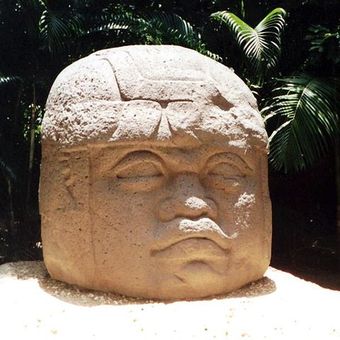
Olmec head
This sculpture is typical of the colossal heads of the Olmec.
The End of the Olmecs
The Olmec population declined sharply between 400 and 350 BCE, though it is unclear why. Archaeologists speculate that the depopulation was caused by environmental changes, specifically riverine environment changes. These changes may have been triggered by the silting up of rivers due to agricultural practices.
Another theory for the considerable population drop relates to tectonic upheavals or subsidence, as suggested by Santley and colleagues who propose relocation of settlements due to volcanism, instead of extinction. Volcanic eruptions during the Early, Late, and Terminal Formative periods would have blanketed the lands and forced the Olmec to move their settlements.
16.3.2: The Mixtec
The Mixtec are a group who lived in modern-day Mexico before the Spanish conquest. People still identify as Mixtec today.
Learning Objective
Distinguish between the Mixtec people and the Mixtec language and identify when they were most prominent
Key Points
- The Mixtec survive today, but reached peak prominence in the 11th century CE.
- The Mixtec language is a set of up to fifty languages, and is not to be confused with the Mixtec people.
- The Mixtec are well known in the anthropological world for their codices, or phonetic pictures in which they wrote their history and genealogies.
Key Terms
- Mixtec
-
Indigenous Mesoamerican peoples inhabiting the region known as La Mixteca, which covers parts of the Mexican states of Oaxaca, Guerrero, and Puebla.
- Codices
-
Phonetic pictures painted on deerskin and folded into books, which recorded Mixtec history and genealogy.
- Tututepec
-
A prominent city center during the height of the Mixtec state, situated along the coast of modern-day Oaxaca.
The Mixtec are indigenous Mesoamerican peoples inhabiting the region known as La Mixteca, which covers parts of the Mexican states of Oaxaca, Guerrero, and Puebla. Though the Mixtec remain today, they were most prominent in the 11th century and the following years, until they were conquered by the Spanish and their allies in the 16th century.
Before the arrival of Spanish hostility, a number of Mixtecan city-states competed with each other and with the Zapotec kingdoms. The major Mixtec polity was Tututepec, which rose to prominence in the 11th century under the leadership of Eight Deer Jaguar Claw. This prominent leader was the only Mixtec king to ever unite the highland and lowland polities into a single Mixtec state. During this era there were approximately 1.5 million Mixtecs populating this varied region.
Modern Mixtec People
Today there are approximately 800,000 Mixtec people in Mexico, and there are also large populations in the United States. In recent years a large exodus of indigenous peoples from Oaxaca, such as the Zapotec and Triqui, have emerged as one of the most numerous groups of Amerindians in the United States. As of 2011, an estimated 150,000 Mixtec people were living in California, and 25,000 to 30,000 were living in New York City. Large Mixtec communities exist in the border cities of Tijuana; Baja California; San Diego, California; and Tucson, Arizona. Mixtec communities are generally described as trans-national or trans-border because of their ability to maintain and reaffirm social ties between their native homelands and diasporic communities.
Mixtec Language
The word “Mixtec” is often used to refer not to the group of people of Mixtec ancestry, but to the family of languages that have developed alongside the group. There is no longer one single Mixtec language; some estimate that there are fifty distinct languages in the Mixtec family, including Cuicatec and Triqui.
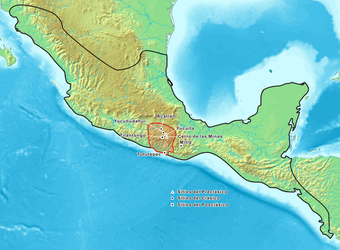
Mixtec’s area
The historical geographic area inhabited by the Mixtec, including the important polities, such as Tututepec.
Mixtec History
Important ancient centers of the Mixtec include the ancient capital of Tilantongo, as well as the sites of Achiutla, Cuilapan, and Yucuñudahui. The Mixtec also erected major constructions at the ancient city of Monte Albán, which had originated as a Zapotec city before the Mixtec gained control of it.
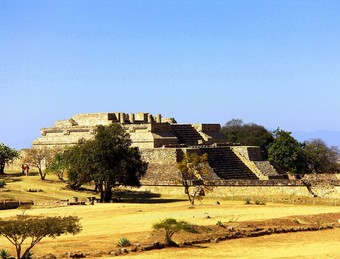
The west side platform at Monte Albán
This ancient city remained a religious site for centuries, and was more sparsely populated during the rise of smaller Mixtec polities. However, religious sites were often reused by Mixtec elites.
At the height of the Aztec Empire (between 1428 and 1521 CE) many Mixtec polities were forced to pay tribute. However, many Mixtec polities remained completely independent of the threatening empire, even as it expanded outward. The smaller Mixtec polities also put up resistance to Spanish forces led by Pedro de Alvarado until the invaders gained control of the region and destroyed any attempt at a revolt in 1521. Disease, weaponry, and local political fractures likely aided the Spanish takeover of the area.
Mixtex Art
The work of Mixtec artisans who produced work in stone, wood, and metal were well regarded throughout ancient Mesoamerica. Mixtec artists were known for their exceptional mastery of jewelry, in which gold and turquoise figured prominently. The intricate metalwork of Mixtec goldsmiths formed an important part of the tribute the Mixtecs had to pay to the Aztecs during parts of their history.
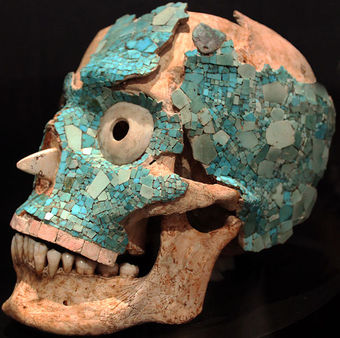
Mixtec funerary mask
Mixtec art included the use of turquoise, gold, and carved stones, and exemplified artistry before the arrival of the Spanish.
Codices
The Mixtec are well known in the anthropological world for their codices, or phonetic pictures, in which they wrote their history and genealogies in deerskin in the “fold-book” form. The best-known story of the Mixtec codices is that of Lord Eight Deer, named after the day on which he was born, whose personal name was Jaguar Claw, and whose epic history is related in several codices. He successfully conquered and united most of the Mixteca region.
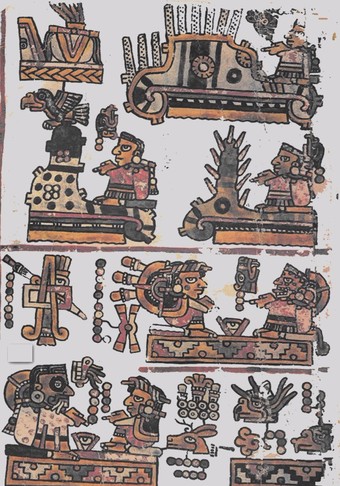
A page from the Codex Bodley
This codex tells the story of the Tilantongo and Tiaxiaco dynasties.
Codices can be read from right to left and often measure many feet long. The Codex Bodley measures twenty-two feet long and contains complex explanations of important family lineages and creation stories, such as the War of Heaven, that directly refer back to elite dynasties. The preservation of these extremely rare Codices paints a distinct picture of Mesoamerica right before the arrival of Spanish forces.
16.3.3: Teotihuacan
Teotihuacan was a city founded outside of modern Mexico City in 100 BCE and was known for its pyramids.
Learning Objective
Discuss the diversity and notable archeological features of Teotihuacan
Key Points
- Teotihuacan was founded around 100 BCE and reached its peak population around 450 CE.
- Teotihuacan was a multi-ethnic city, with distinct quarters occupied by Otomi, Zapotec, Mixtec, Maya and Nahua peoples.
- The geographical layout of Teotihuacan is a good example of the Mesoamerican tradition of planning cities, settlements, and buildings as a reflections of their view of the Universe.
Key Terms
- Pyramid of the Sun
-
The largest building in Teotihuacan, which measures 246 feet high and 736 feet wide.
- Teotihuacan
-
A large precolumbian Mesoamerican city known for its archeological significance.
- The Great Goddess
-
This deity was one of the central icons of Teotihuacano religious culture. She appears in painted murals with images associated with the underworld, birth, death, and creation.
Just 30 miles from modern day Mexico City lies the precolumbian Mesoamerican city of Teotihuacan. It is famous for its pyramids and series of accompanying residential compounds, but was once much more than an archaeological and tourist site.
Archaeological evidence suggests that Teotihuacan was a multi-ethnic city, with distinct quarters occupied by Otomi, Totonac, Zapotec, Mixtec, Maya, and Nahua peoples. In 2001, Terrence Kaufman presented linguistic evidence suggesting that an important ethnic group in Teotihuacan was of Totonacan or Mixe–Zoquean linguistic affiliation. Other scholars maintain that the largest population group must have been of Otomi ethnicity, because the Otomi language is known to have been spoken in the area around Teotihuacan both before and after the classic period and not during the middle period.
Although it is a subject of debate whether Teotihuacan was the center of a state empire, its influence throughout Mesoamerica is well documented; evidence of Teotihuacano presence can be seen at numerous sites in Veracruz and the Maya region. Many Maya murals represent Teotihucuan and the leaders of the city during its zenith. The Aztecs were also heavily influenced by the architecture, culture, and lore of this ancient city, claiming common ancestry with the Teotihuacanos and adopting some of their artistic and architectural styles.
Founding of the City
The city and culture, which can be referred to as Teotihuacan or Teotihuacano, is thought to have been established around 100 BCE, with major monuments continuously under construction until about 250 CE. It began as a new religious center in the Mexican Highland and a large population was drawn to the city over a few centuries. It may have lasted until sometime between the 7th and 8th centuries CE, but its major monuments were sacked and systematically burned around 550 CE. At its zenith, around the first half of the first millennium CE, Teotihuacan was the largest city in the pre-Columbian Americas, with a population estimated at 125,000 or more. It’s varied population made it, at minimum, the sixth largest city in the world during its epoch. The city eventually included multi-floor apartment compounds built to accommodate this large population.
Mysterious Founders and Religion
The founders of this religious and populous city remain a mystery to scholars of the area. Some have speculated that the Xitle volcano, which is located southwest of modern-day Mexico City, may have prompted a mass emigration out of the central valley and into the Teotihuacan valley. These displaced settlers may have founded, or at least helped grow, the city.
An alternate explanation is that the Totonac people, who still remain today, founded Teotihuacan. There is also evidence that at least some of the people living in Teotihuacan immigrated from those areas influenced by the Teotihuacano civilization, including the Zapotec, Mixtec, and Maya peoples.
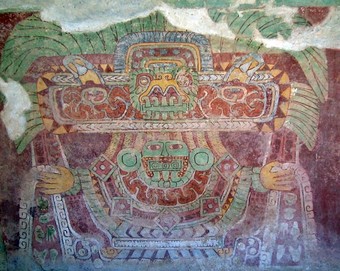
Mural of the Great Goddess of Teotihuacan
This powerful goddess was associated with darkness, mystery, death, and creation. She was often depicted with owls, jaguars, and spiders, all creatures of the earth, darkness and the underworld. This mural is from the Tetitla compound at Teotihuacan.
As a religious center, Teotihuacan displayed its most prominent gods and goddesses in murals and architecture. The Great Goddess of Teotihuacan appears to be the most prominent of these deities, and she likely represented the underworld, war, creation, water, and the earth. Evidence of human sacrifices to honor the completion of buildings or special times of year has also been uncovered by archeologists. Captives from wars were decapitated, had their hearts removed, were bludgeoned, or were buried alive to commemorate these momentous occasions.
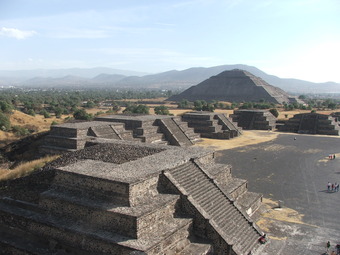
Pyramid of the Sun
This giant pyramid dwarfs the smaller platforms surrounding it and was the largest building at Teotihuacan.
Layout
The city’s broad central avenue, called “Avenue of the Dead” (a translation from its Nahuatl name Miccoatli), is flanked by impressive ceremonial architecture, including the immense Pyramid of the Sun (third largest in the World after the Great Pyramid of Cholula and the Great Pyramid of Giza) and the Pyramid of the Moon. Along the Avenue of the Dead are many smaller talud-tablero platforms. The Aztecs believed they were tombs, inspiring the Nahuatl name of the avenue.
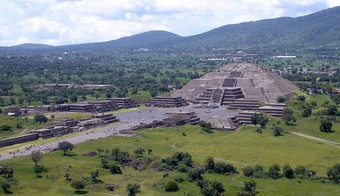
Pyramid of the Moon
This pyramid is the second largest in Teotihuacan.
Further down the Avenue of the Dead is the area known as the Citadel, containing the ruined Temple of the Feathered Serpent. This area was a large plaza surrounded by temples that formed the religious and political center of the city. Most of the common people lived in large apartment buildings spread across the city. Many of the buildings contained workshops where artisans produced pottery and other goods.
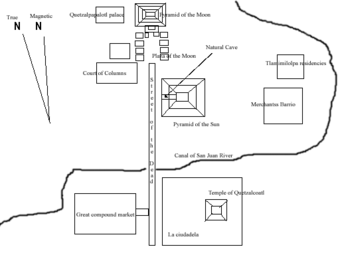
Teotihuacan City Plan
The layout of Teotihuacan exemplifies Mesoamerican urban planning
The geographical layout of Teotihuacan is a good example of the Mesoamerican tradition of planning cities, settlements, and buildings as a reflection of the Universe. Its urban grid is aligned to precisely 15.5º east of North. One theory says this is due to the fact that the sun rose at that same angle during the same summer day each year. Settlers used the alignment to calibrate their sense of time or as a marker for planting crops or performing certain rituals. Another theory is that there are numerous ancient sites in Mesoamerica that seem to be oriented with the tallest mountain in their given area. This appears to be the case at Teotihuacan, although the mountain to which it is oriented is not visible from within the Teotihuacan complex due to a closer mountain ridge. Pecked-cross circles throughout the city and in the surrounding regions indicate how the people managed to maintain the urban grid over long distances. It also enabled them to orient the Pyramids to the distant mountain that was out of sight.
Fall of Teotihuacan
There is an ongoing debate about why Teotihuacan collapsed and the population abandoned this city center. Evidence of climate changes, which caused severe droughts around 535 CE, suggest there was a general population decline in the region. In fact, archeological digs have revealed juvenile skeletons with signs of malnutrition, which probably forced populations to move and caused internal social strife. Further archeological evidence reveals that only the buildings associated with the elites along the Avenue of the Dead were sacked and burned. This type of activity suggests there might have been internal unrest and possibly a revolt against the elite power structure, which caused the collapse of the city.
16.3.4: The Zapotec
The Zapotec civilization developed in modern-day Mexico and lasted from approximately the 6th century BCE to the 16th century CE.
Learning Objective
Explain the culture, religion, expansion, and demise of the Zapotec civilization
Key Points
- The Zapotec civilization originated in the three Central Valleys of Oaxaca in the late 6th Century BCE.
- There are five distinct Zapotec periods, denoted Monte Albán 1–5 (after the place of origin).
- The Zapotec were polytheists who developed a calendar and logosyllabic writing system.
Key Terms
- Monte Alban
-
The place of origin for the Zapotec civilization.
- Cocijo
-
The lightning and rain god of the Zapotec civilization. He was the most important of the religious figures and was believed to have created the universe with his breath.
- Mitla
-
The main religious city of the Zapotec culture. Elaborate buildings and artwork display the richness of religious life for the Zapotec elite.
The Zapotec civilization originated in the three Central Valleys of Oaxaca in the late 6th Century BCE. The valleys were divided between three different-sized societies, separated by no-man’s-land in the middle, today occupied by the city of Oaxaca. Archaeological evidence from the period, such as burned temples and sacrificed captives, suggests that although the three societies shared linguistic, cultural, and religious traditions, they also competed against one another.

Panorama from Monte Albán
The view from the site of origin of the Zapotec rulers that expanded power beyond the Central Valleys of Oaxaca.
Five Phases
The Zapotec state formed at Monte Albán. This consolidation of power began outward political expansion during the late Monte Albán 1 phase (400–100 BCE) and throughout the Monte Albán 2 phase (100 BCE–200 CE). Zapotec rulers from Monte Albán seized control of provinces outside the valley of Oaxaca with their superior military and political clout, which quickly overtook less-developed local entities. By 200 CE, the end of the Monte Albán 2 phase, the Zapotecs had extended their influence, from Quiotepec in the North to Ocelotepec and Chiltepec in the South. The religious and cultural city of Monte Albán had become the largest city in what are today the southern Mexican highlands. This powerful city retained this status until approximately 700 CE.
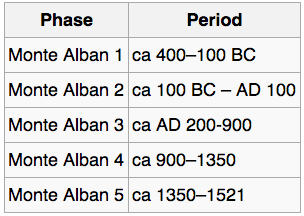
Monte Albán phases
Historical Monte Albán phases and the duration of each phase.
Expansion and Decline
Between Monte Albán phases 1 and 2 there was a considerable expansion of the population of the Valley of Oaxaca. As the population grew, so did the degree of social differentiation, the centralization of political power, and ceremonial activity. Another effect of this population boom and the political expansion of the military during Monte Albán 1–2 was the development of fragmented, independent states. These areas developed regional centers of power with distinct leaders and linguistic dialects. However, the Zapotec rulers retained control over vast swaths of the region. Some archeologists argue that the building centered on the main plaza of Monte Albán contains depictions of elaborate heads, which represent the rulers of conquered provinces.
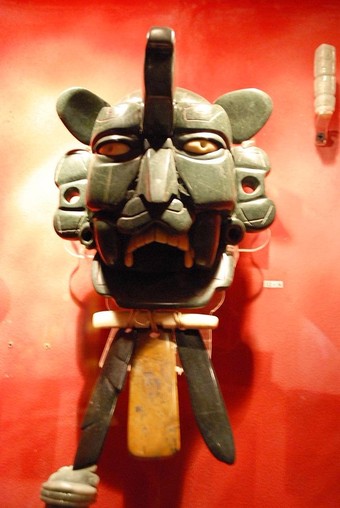
Jade warrior mask from Monte Albán
This jade replica illustrates the fierce military presence that initially expanded the Zapotec holdings during Monte Albán phase 2.
The Zapotecs were ultimately destroyed by Spanish invaders. Having lost militarily to the Aztecs in battles from 1497–1502, the Zapotecs tried to avoid confrontation with the Spaniards, and hopefully the tragic fate of the Aztecs. The Spaniards took advantage of this pacifist stance and ultimately defeated the Zapotecs after five years of campaigns ending in 1527. The arrival of new diseases and steel weapons also weakened any attempts at a revolt from the Zapotec population. There were some subsequent uprisings against the new rulers, but for all intents and purposes, the Zapotecs were conquered. However, the seven Zapotec languages, and hundreds of Zapotec dialects, still survive with populations that have spread throughout Mexico and also Los Angeles, California.
Zapotec Writing and Religion
The Zapotecs developed a calendar and a logosyllabic system of writing that used a separate glyph to represent each of the syllables of the language. This writing system is thought to be one of the first writing systems of Mesoamerica and a predecessor of those developed by the Maya, Mixtec, and Aztec civilizations.
Like most Mesoamerican religious systems, the Zapotec religion was polytheistic. Two principal deities included Cocijo, the rain god (similar to the Aztec god Tlaloc), and Coquihani, the god of light. These deities, along with many others, centered around concepts of fertility and agriculture. It is likely that the Zapotec practiced human sacrifices to these gods of fertility, and also played elaborate and ritualistic ball games in the court at Monte Albán. They also practiced dedication rituals, which cleansed a new space. Fine pieces of rare jade, pearl, and obsidian were found in a cache in Oaxaca, and were probably used to cleanse religious sites or temples upon the completion of construction.
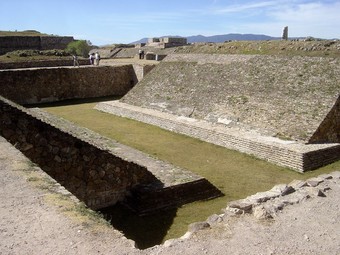
The ball court at Monte Albán
A religious ball game utilizing a rubber ball was practiced throughout Mesoamerica by young men playing for sacred, and often sacrificial, purposes.
According to historic, as well as contemporary, Zapotec legends, their ancestors emerged from the earth or from caves, or turned into people from trees or jaguars. Their governing elite apparently believed that they descended from supernatural beings that lived among the clouds, and that upon death they would return to the same status. In fact, the name by which Zapotecs are known today results from this belief. The Zapotecs of the Central Valleys call themselves “Be’ena’ Za’a”—the Cloud People.
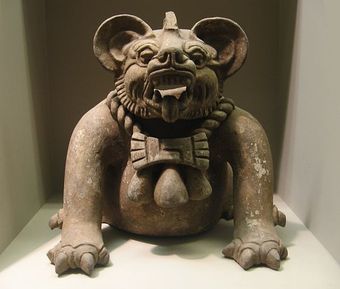
A funerary urn in the shape of a “bat god” or a jaguar
c. 300–650 CE. Height: 9.5 in (23 cm).
Mitla
Evidence of the central role of religion in the Zapotec cultural hierarchy is pronounced at the religious city of Mitla. It is the second most important archeological site in the state of Oaxaca, and the most important of the Zapotec culture. The site is located 44 kilometers from the city of Oaxaca. While Monte Albán was most important as the political center, Mitla was the main religious center, as evidenced by the elaborate buildings and artwork throughout the city. The name “Mitla” is derived from the Nahuatl name “Mictlán,” which was the place of the dead or underworld. Its Zapotec name is Lyobaa, which means “place of rest.” The name “Mictlán” was Hispanicized to “Mitla” by the Spanish.
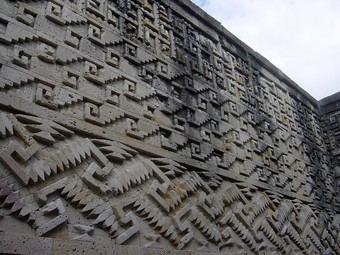
Fretwork on a building in the religious capital of Mitla
This complex fretwork illustrates the religious importance of this ancient city in the Zapotec culture.
What makes Mitla unique among Mesoamerican sites is the elaborate and intricate mosaic fretwork and geometric designs that cover tombs, panels, friezes, and even entire walls. These mosaics are made with small, finely cut and polished stone pieces, which have been fitted together without the use of mortar. No other site in Mexico has this.
16.4: The Maya
16.4.1: The Preclassic Period of the Maya
The Preclassic period lasted from 2000 BCE to 250 CE and saw the emergence of many distinctive elements of Mayan civilization.
Learning Objective
Describe life in the Preclassic period
Key Points
- The Preclassic period itself is further divided into four periods: Early Preclassic, Middle Preclassic, Late Preclassic, and Terminal Preclassic.
- The Early Preclassic period (2000–1000 BCE) was when the Maya transitioned into an agrarian society.
- In the Middle Preclassic period (1000–400 BCE), the Mayans built more established cities and expanded through war.
- Two powerful states emerged in the Late Preclassic period (400 BCE–100 CE).
- The Mayan civilization collapsed and left the major Preclassic capitals behind at the end of the Terminal Preclassic period (100–250 CE) for unknown reasons.
Key Terms
- kakaw
-
An Olmec word for the cacao plant. This word was borrowed and incorporated into the Mayan language, illustrating the relationship between these two cultures.
- Southern Maya Area
-
The geographic region in which Mayan civilization first emerged.
- Kaminaljuyu
-
The ruling city-state of the Middle Preclassic era. Evidence of stone monuments and complex canals illustrate the power this early capital retained for centuries.
The Preclassic period is the first of three periods in Mayan history, coming before the Classic and Postclassic periods. It extended from the emergence of the first settlements sometime between 2000 and 1500 BCE until 250 CE. The Preclassic period saw the rise of large-scale ceremonial architecture, writing, cities, and states. Many of the distinctive elements of Mesoamerican civilization can be traced back to this period, including the dominance of corn, the building of pyramids, human sacrifice, jaguar worship, the complex calendar, and many of the gods.
Mayan language speakers most likely originated in the Chiapas-Guatamalan Highlands and dispersed from there. By around 2500–2000 BCE researchers can begin to trace the arc of Mayan-language settlements and culture in what is now southeastern Mexico, Guatemala, and Belize. The Preclassic period itself is divided into four periods: Early Preclassic, Middle Preclassic, Late Preclassic, and Terminal Preclassic
Agricultural Shift – Early Preclassic (2000 BCE–1000 BCE)
Though the exact starting date of Mayan civilization is unclear, there were Mayan language speakers in the Southern Maya Area by 2000 BCE. It appears that around this time the Maya people began to transition from a hunter-gatherer lifestyle to a culture based around agricultural villages. The process appears to have been a gradual one. Analysis of bones from early Maya grave sites indicates that, although maize had already become a major component of the diet by this time, fish, meat from game animals, and other hunted or gathered foods still made up a major component of the diet. Along with the gradual development of agriculture, basic forms of pottery began to appear, with simple designs and some slipped vessels.
Around this time, the Olmec culture began to emerge in nearby Tabasco, granting the early Maya an important trading partner and beginning a period of prolonged contact that would have profound effects on Maya society and artistic production.
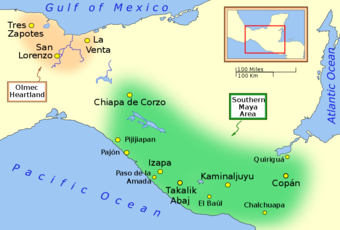
Southern Maya Area
By 2000 BCE, there were speakers of Mayan languages in the Southern Maya Area.
Complex Cities – Middle Preclassic (1000 BCE–400 BCE)
By around the year 1000 BCE, centuries of agricultural village life had begun to form the beginnings of a complex society, with an elite class, entrenched religious practices, and a military presence. Other developments of this era include the following:
- Prestige goods, such as obsidian mirrors and jade mosaics, began to appear, increasing the demand for more extensive trade with other language groups, including the Olmecs.
- Canals and irrigation schemes demanding coordinated human effort began to appear with increasing complexity and scale.
- Villages began to include central plazas and earthen mounds, occasionally enhanced by masonry. For instance, the site of La Blanca featured a central mound more than seventy-five feet tall. It contained a masonry fragment strongly resembling a head in the distinctive Olmec style. These plazas also suggest a developing religious and hierarchical social structure.
- Carved stone stele also began to appear during this period, adorned with portraits of rulers but still devoid of writing.
- Warfare appears to have intensified during this period, as evidenced by advanced weaponry, rulers beginning to be portrayed as warriors, and the appearance of mass graves and decapitated skeletons.
Beginning around 900 BCE, the Pacific coastal region fell under the dominance of the La Blanca statelet, which collapsed around 600 BCE, to be replaced by a polity centered around the El Ujuxte site. Another early statelet was probably based at the site of Chalchuapa, a town with extensive earthen mounds arranged around several plazas. However, it was likely ruled by the first true Mayan city-state, Kaminaljuyu.
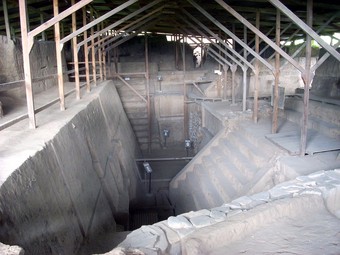
Excavation site at Kaminaljuyu
Complex temples, stairways, and friezes illustrate the acme of this Preclassic city’s power and influence.
Lying within modern-day Guatemala City on the shores of Lake Miraflores, Kaminaljuyu developed a powerful government structure that organized massive irrigation campaigns and built numerous intricately carved stone monuments to its rulers. These monuments clearly depict war captives and often show the rulers holding weapons. These images indicate the Kaminaljuyu polity engaged in active warfare and dominated the Guatemalan highlands for centuries.
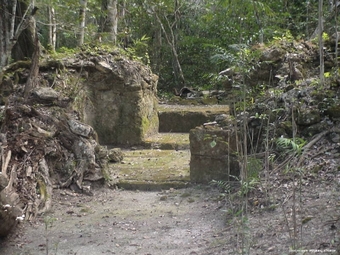
Nakbe Palace
The ruins of a Middle Preclassic palace at Nakbe.
During this period, the Olmec culture reached its zenith, centered around the capital of La Venta in modern-day Tabasco near the early Maya centers. Speakers of a Mixe–Zoquean language, the Olmec are generally recognized as the first true civilization in the Americas. Their capital city of La Venta contains extensive earthworks and stone monuments, including several of the distinctive Olmec stone heads. The Olmec share several features with later Maya culture, including extensive jaguar worship, a diet dominated by maize, and the use of the cacao plant. Several words entered Mayan from a Mixe–Zoquean language, presumably due to Olmec influence. These words include the words “ajaw,” meaning “lord,” and “kakaw,” which has become the English words “cacao” and “chocolate. ” Most of these borrowings relate to prestige concepts and high culture, indicating that the Middle Preclassic Maya were deeply impressed and influenced by their northwestern neighbors.
Art and Language – Late Preclassic (400 BCE–100 CE)
Some of the earliest remaining examples of the complex writing system of the Maya appear from the 3rd century BCE. The glyph-based system represents complex concepts and often reflects the religious beliefs of the Maya, including jaguar worship, elites practicing blood letting rituals, and offerings to deities. The Maya also developed the concept of the number zero during this era. The appearance of an explicit number zero in their written records might be the first example of it worldwide. The appearance of this number also helped Mayan architects and priests make exact calculations of the stars and buildings for religious and social purposes.
The Late Preclassic also saw the rise of two powerful states that rival later Classic Mayan city-states for scale and monumental architecture—Kaminaljuyu in the highlands and El Mirador in the lowlands. Both cities display the continued refinement in stonework, artistic friezes, and architecture during this era.
City Collapse – Terminal Preclassic (100 CE–250 CE)
The Late or Terminal Preclassic murals found in San Bartolo reflect the profound relationship between the Olmec and Maya civilizations over hundreds of years, due to the striking artistic similarities. These murals also provide a window into the Terminal Preclassic sacrificial and inauguration rituals, such as bloodletting, that were practiced around 100 BCE. Elites were expected to perform these painful rituals in reverence to powerful deities.
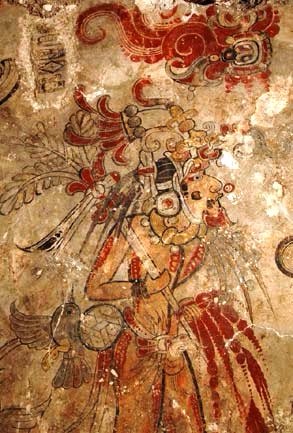
Painted mural at San Bartolo from around 100 BCE
This colorful mural depicts a king practicing bloodletting, probably for an inauguration or other sacrificial purpose.
The collapse of the Preclassic Maya civilization remains a mystery, and little is known as to why the major cities were abandoned around 250 CE. However, there were actually two collapses, one at the end of the Preclassic and a more famous one at the end of the Classic. The Preclassic collapse refers to the systematic decline and abandoning of the major Preclassic cities, such as Kaminaljuyu and El Mirador around 100 CE. In fact, the Maya remained an essential part of the region. A number of theories have been proposed, but there is as little consensus as there is for the causes of the more famous collapse between the Classic and Postclassic periods.
16.4.2: The Classic Period of the Maya
The Classic period lasted from 250 to 900 CE and was the peak of the Maya civilization.
Learning Objective
Describe life, religion, and architecture in the Classic period
Key Points
- The Maya developed an agriculturally intensive, city-centered civilization consisting of numerous independent city-states of varying power and influence.
- The Maya civilization participated in long-distance trade with many other Mesoamerican cultures and established trade routes between city-states.
- The Maya used complex calendars to calculate religious, solar, and lunar cycles.
- The cause of the collapse of the Maya civilization is unknown.
Key Terms
- Copán
-
An important city that boasted some of the most complex architecture from the Classic period of Maya history.
- Tzolkin
-
This 365-day solar calendar utilized the movement of Earth around the Sun to calculate the year.
- stelae
-
Carved stones depicting rulers with heirogliphic texts describing their accomplishments.
The Classic period lasted from 250 to 900 CE. It saw a peak in large-scale construction and urbanism, the recording of monumental inscriptions, and significant intellectual and artistic development, particularly in the southern lowland regions. During this period the Maya population numbered in the millions, with many cities containing 50,000 to 120,00o people. The Maya developed an agriculturally intensive, city-centered civilization consisting of numerous independent city-states of varying power and influence. They created a multitude of kingdoms and small empires, built monumental palaces and temples, engaged in highly developed ceremonies, and developed an elaborate hieroglyphic writing system.
The political, economic, and culturally dominant “core” Maya units of the Classic Maya world system were located in the central lowlands, while the corresponding peripheral Maya units were found along the margins of the southern highland and northern lowland areas. The semi-peripheral (mediational) units generally took the form of trade and commercial centers. But as in all world systems, the Maya core centers shifted through time, starting out during Preclassic times in the southern highlands, moving to the central lowlands during the Classic period, and finally shifting to the northern peninsula during the Postclassic period.
Monuments
The most notable monuments are the stepped pyramids the Maya built in their religious centers and the accompanying palaces of their rulers. The palace at Cancuén is the largest in the Maya area, but the site has no pyramids. On the other hand, cities like Tikal and Copán illustrate the wealth of architectural accomplishments during these prolific centuries. Copán came to its full power between the 6th and 8th centuries, and included massive temples and carvings that illustrate the full power of its ruling, and often merciless, emperors.
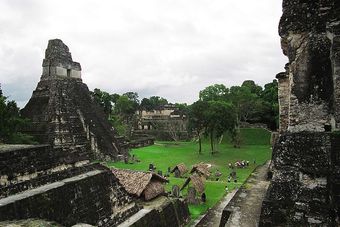
Tikal Temple
Classic period temple from Tikal, Guatemala.
The cities of Palenque and Yaxchilan were also cultural and religious centers in the southeastern Maya region, and included large temples, ball courts, and even a uniquely vaulted ceiling in the hallway of the Palenque Palace.
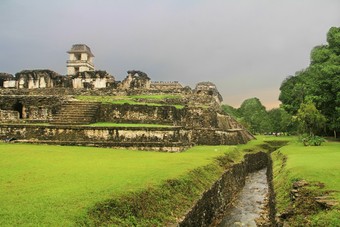
The Palenque Palace and aqueduct
Cities like Palenque boasted some of the most refined architectural works in the Classic period of Maya culture.
Other important archaeological remains include the carved stone slabs usually called stelae (the Maya called them tetun, or “tree-stones”), which depict rulers along with hieroglyphic texts describing their genealogy, military victories, and other accomplishments.
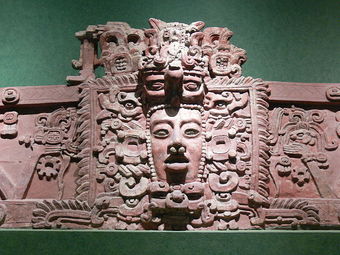
Maya mask
Stucco frieze from Placeres, Campeche. Early Classic period (c. 250–600 CE).
Trade
The political relationship between Classic Maya city-states has been likened to the relationships between city-states in Classical Greece and Renaissance Italy. Some cities were linked to each other by straight limestone causeways, known as sacbeob. Whether the exact function of these roads was commercial, political, or religious has not been determined.
The Maya civilization participated in long distance trade with many other Mesoamerican cultures, including Teotihuacan, the Zapotec, and other groups in central and gulf-coast Mexico. In addition, they traded with more distant, non-Mesoamerican groups, such as the Taínos of the Caribbean islands. Archeologists have also found gold from Panama in the Sacred Cenote of Chichen Itza. Important trade goods included:
- Cacao
- Salt
- Seashells
- Jade
- Obsidian
Calendars and Religion
The Maya utilized complex mathematical and astronomical calculations to build their monuments and conceptualize the cosmography of their religion. Each of the four directions represented specific deities, colors, and elements. The underworld, the cosmos, and the great tree of life at the center of the world all played their part in how buildings were built and when feasts or sacrifices were practiced. Ancestors and deities helped weave the various levels of existence together through ritual, sacrifice, and measured solar years.
The Maya developed a mathematical system that is strikingly similar to the Olmec traditions. The Maya also linked this complex system to the deity Itzamna. This deity was believed to have brought much of Maya culture to Earth. A 260-day calendar (Tzolkin) was combined with the 365-day solar calendar (Haab’) to create a calendar round. This calendar round would take fifty-two solar years to return to the original first date. The Tzolkin calendar was used to calculate exact religious festival days. It utilized twenty named days that repeated thirteen times in that calendar year. The solar calendar (Haab’) is very similar to the modern solar calendar year that uses Earth’s orbit around the Sun to measure time. The Maya believed there were five chaotic days at the end of the solar year that allowed the portals between worlds to open up, known as Wayeb’.
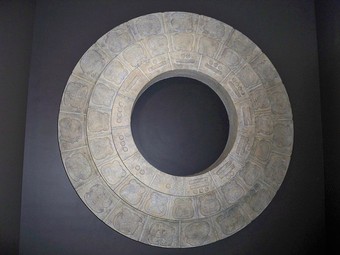
A Classic period Maya calendar
Each symbol represents a specific day within the calendar. When the Tzolkin and Haab’ calendar’s are combined they create a fifty-two-year solar calendar.
These calendars were recorded utilizing specific symbols for each day in the two central cycles. Calendrical stones were employed to carefully follow the movement of the solar and religious years. Although less commonly used, the Maya also employed a long count calendar that calculated dates hundreds of years in the future. They also inscribed a lengthier 819-day calendar on many religious temples throughout the region that most likely coincided with important religious days.
Decline
The Classic Maya Collapse refers to the decline of the Maya Classic Period and abandonment of the Classic Period Maya cities of the southern Maya lowlands of Mesoamerica between the 8th and 9th centuries. This should not be confused with the collapse of the Preclassic Maya in the 2nd century CE. The Classic Period of Mesoamerican chronology is generally defined as the period from 300 to 900 CE, the last 100 years of which, from 800 to 900 CE, are frequently referred to as the Terminal Classic.
It has been hypothesized that the decline of the Maya is related to the collapse of their intricate trade systems, especially those connected to the central Mexican city of Teotihuacán. Before there was a greater knowledge of the chronology of Mesoamerica, Teotihuacan was believed to have fallen during 700–750 CE, forcing the “restructuring of economic relations throughout highland Mesoamerica and the Gulf Coast.” This remaking of relationships between civilizations would have then given the collapse of the Classic Maya a slightly later date. However, it is now believed that the strongest Teotihuacan influence was during the 4th and 5th centuries. In addition, the civilization of Teotihuacan started to lose its power, and maybe even abandoned the city, during 600–650 CE. The Maya civilizations are now thought to have lived on, and also prospered, perhaps for another century after the fall of Teotihuacano influence.
The Classic Maya Collapse is one of the biggest mysteries in archaeology. The classic Maya urban centers of the southern lowlands, among them Palenque, Copán, Tikal, Calakmul, and many others, went into decline during the 8th and 9th centuries and were abandoned shortly thereafter. Some 88 different theories, or variations of theories, attempting to explain the Classic Maya Collapse have been identified. From climate change, to deforestation, to lack of action by Maya kings, there is no universally accepted collapse theory, although drought is gaining momentum as the leading explanation.
16.4.3: The Decline of the Maya
The period after the second collapse of the Maya Empire (900 CE–1600 CE) is called the Postclassic period.
Learning Objective
Explain what happened to the structure of the Maya Empire in the Postclassic period
Key Points
- The Maya cities of the northern lowlands in Yucatán continued to flourish.
- The center of power shifted to the northern peninsula.
- The Postclassic period was a time of technological advancement in areas of architecture, engineering, and weaponry.
- The Spanish conquest of the Maya began in the 16th century, but lasted close to 150 years.
- Mayan languages, agricultural practices, and familial cultures still exist in parts of Chiapas and Guatemala.
Key Terms
- Yucatán
-
A geographic area in the south of modern day Mexico near Belize.
- Codex
-
A book containing religious and cultural information written in the Mayan script. Only three of these books remain in the world.
- Mayapan
-
The cultural capital of the Maya culture during the Postclassic period. It was at its height between 1220 and 1440 CE.
The period after the second collapse of the Maya Empire (900 CE–1600 CE) is called the Postclassic period. The center of power shifted from the central lowlands to the northern peninsula as populations most likely searched for reliable water resources, along with greater social stability.
The Maya cities of the northern lowlands in Yucatán continued to flourish; some of the important sites in this era were Chichén Itzá, Uxmal, Edzná, and Coba. A typical Classic Maya polity was a small hierarchical state (called an ajawil, ajawlel, or ajawlil) headed by a hereditary ruler known as an ajaw (later k’uhul ajaw). However, the Postclassic period generally saw the widespread abandonment of once-thriving sites as populations gathered closer to water sources. Warfare most likely caused populations in long-inhabited religious cities, like Kuminaljuyu, to be abandoned in favor of smaller, hilltop settlements that had a better advantage against warring factions.
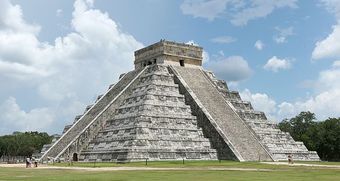
El Castillo (pyramid of Kukulcán) in Chichén Itzá
Built by the pre-Columbian Maya civilization sometime between the 9th and 12th centuries CE, El Castillo served as a temple to the god Kukulkan, the Yucatec Maya Feathered Serpent deity closely related to the god Quetzalcoatl known to the Aztecs and other central Mexican cultures of the Postclassic period.
Postclassic Cities
Maya cities during this era were dispersed settlements, often centered around the temples or palaces of a ruling dynasty or elite in that particular area. Cities remained the locales of administrative duties and royal religious practices, and the sites where luxury items were created and consumed. City centers also provided the sacred space for privileged nobles to approach the holy ruler and the places where aesthetic values of the high culture were formulated and disseminated and where aesthetic items were consumed. These more established cities were the self-proclaimed centers of social, moral, and cosmic order.
If a royal court fell out of favor with the people, as in the well-documented cases of Piedras Negras or Copan, this fall from power would cause the inevitable “death” and abandonment of the associated settlement. After the decline of the ruling dynasties of Chichén Itzá and Uxmal, Mayapan became the most important cultural site until about 1450 CE. This city’s name may be the source of the word “Maya,” which had a more geographically restricted meaning in Yucatec and colonial Spanish. The name only grew to its current meaning in the 19th and 20th centuries. The area degenerated into competing city-states until the Spanish arrived in the Yucatán and shifted the power dynamics.
Certain smaller Maya groups, such as the Itza Maya, Ko’woj, and Yalain of Central Peten, survived the collapse in the Postclassic period in small numbers. By around 1250 CE these groups had reconstituted themselves to form competing city-states. The Itza maintained their capital at Tayasal (also known as Noh Petén), an archaeological site thought to underlay the modern city of Flores, Guatemala, on Lake Petén Itzá. The Ko’woj had their capital at Zacpeten. Though less visible during this era, Postclassic Maya states also continued to survive in the southern highlands.
Artistry, Architecture, and Religion
The Postclassic period is often viewed as a period of cultural decline. However, it was a time of technological advancement in areas of architecture, engineering, and weaponry. Metallurgy came into use for jewelry and the development of some tools utilizing new metal alloys and metalworking techniques that developed within a few centuries. And although some of the classic cities had been abandoned after 900 CE, architecture continued to develop and thrive in newly flourishing city-states, such as Mayapan. Religious and royal architecture retained themes of death, rebirth, natural resources, and the afterlife in their motifs and designs. Ballcourts, walkways, waterways, pyramids, and temples from the Classic period continued to play essential roles in the hierarchical world of Maya city-states.
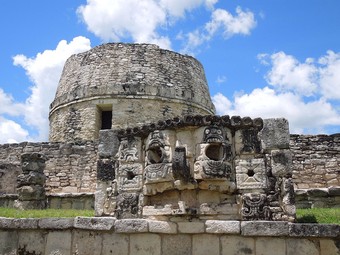
A religious building at Mayapan along the northern Yucatán Peninsula
Curved walls, complex carvings, and layered platforms illustrate the continued prevalence of architecture in Maya culture and religion during the Postclassic period.
Maya religion continued to be centered around the worship of male ancestors. These patrilineal intermediaries could vouch for mortals in the physical world from their position in the afterlife. Archeological evidence shows that deceased relatives were buried under the floor of family homes. Royal dynasties built pyramids in order to bury their ancestors. This patrilineal form of worship was used by some royal dynasties in order to justify their right to rule. The afterlife was complex, and included thirteen levels in heaven and nine levels in the underworld, which had to be navigated by an initiated priesthood, ancestors, and powerful deities.
Precise food preparation, offerings, and astronomical predictions were all required for religious practices. Powerful deities that often represented natural elements, such as jaguars, rain, and hummingbirds, needed to be placated with offerings and prayers regularly. Many of the motifs on large pyramids and temples of the royal dynasties reflect the worship of both deities and patrilineal ancestors and provide a window into the daily practices of this culture before the arrival of Spanish forces.
The Colonial Period
Shortly after their first expeditions to the region in the 16th century, the Spanish attempted to subjugate the Maya polities several times. The Maya leaders and people were understandably hostile towards the Spanish crown, and utilized bows and arrows, spears, and padded armor in defense of their city-states. The Spanish campaign, sometimes termed “The Spanish Conquest of Yucatán,” would prove to be a lengthy and dangerous exercise for the invaders from the outset, and it would take some 170 years and tens of thousands of Indian auxiliaries before the Spanish established substantive control over all Maya lands.

Pages from the Paris Codex
One of three surviving examples of Mayan writing, the Paris Codex offers keen insights into religious and patrilineal traditions before the Spanish invasion.
Unlike the Aztec and Inca Empires, there was no single Maya political center during the Postclassic period that, once overthrown, would hasten the end of collective resistance from the indigenous peoples. Instead, Spanish forces needed to subdue the numerous independent Maya polities almost one by one, many of which kept up a fierce resistance. Myths of gold and precious metals motivated many Spanish forces to capture and dominate the Maya lands. However, the Yucatán does not offer rich mining opportunities, and some areas were difficult to navigate because of the dense jungle environment.
As the battle over control of the region waged on, the Spanish church and government officials destroyed the vast majority of Maya texts and, with them, a large swath of knowledge about Maya writing and language. Fortunately, three of the pre-Columbian books dated to the Postclassic period survived the Spanish invasion and destruction of Maya culture. These are known as the Madrid Codex, the Dresden Codex, and the Paris Codex. The last Maya states (and the last indigenous holdouts from Spanish control in the Americas)—the Itza polity of Tayasal and the Ko’woj city of Zacpeten—remained independent of the Spanish until late in the 17th century. They were finally subdued by the Spanish in 1697 after many casualties.
Maya Today
Although Spanish weaponry, administration, and practices became much more dominant throughout Mesoamerica by the 17th century and onward, the Maya people persisted, along with many of their essential traditions. Today, in remote parts of Guatemala and Chiapas, similar familial configurations, uses of the 260-day Maya calendar, and agricultural practices continue to shape families of descendants. Millions of Mayan-language speakers inhabit their ancestral lands and keep these languages and traditions alive.
16.5: The Toltecs and the Aztecs
16.5.1: The Toltecs
The Toltecs were a Mesoamerican people who preceded the Aztecs and existed between 800 and 1000 CE.
Learning Objective
Identify the Toltecs
Key Points
- Much of what is known about the Toltecs is based on what has been learned about the Aztecs.
- Historicists believe that Aztec accounts of the Toltecs can be trusted as historical sources.
- Others believe that Aztec accounts are too shrouded in myth to be trusted as sources of truth.
- Certain Mayan sites, such as Chichén Itzá, share distinctive archeological traits with religious monuments and buildings in Tula.
Key Terms
- Quetzalcoatl
-
The feathered serpent deity that appears in carvings at Tula and also in much later buildings and mythology in the Aztec Empire.
- Historicist
-
A scholar that utilizes Aztec accounts of Toltec culture to piece together the history of the Toltec people.
- Atlantean figures
-
Gigantic stone statues of Toltec warriors that only appear at the sites of Tula, Chichén Itzá, and Potrero Nuevo.
The Toltec culture is an archaeological Mesoamerican culture that dominated a state centered in Tula in the early Postclassic period of Mesoamerican chronology (c. 800–1000 CE). Much of what is known about the Toltecs is based on what has been learned about the Aztecs, another Mesoamerican culture that postdated the Toltecs and admired the Toltecs as predecessors. Since so much of what remains on record about the Toltecs may have been tainted by Aztec glorification and mythology in the 14th through 16th centuries, it is difficult to parse out the true history.
The later Aztec culture saw the Toltecs as their intellectual and cultural predecessors, and described Toltec culture emanating from Tōllān [ˈtoːlːaːn] (Nahuatl for Tula) as the epitome of civilization. Indeed, in the Nahuatl language the word “Tōltēcatl” [toːlˈteːkat͡] (singular) or “Tōltēcah” [toːlˈteːkaʔ] (plural) came to take on the meaning “artisan.” The Aztec oral and pictographic tradition also described the history of the Toltec Empire, giving lists of rulers and their exploits.
Among modern scholars it is a matter of debate whether the Aztec narratives of Toltec history should be given credence as descriptions of actual historical events. While all scholars acknowledge that there is a large mythological part of the narrative, some maintain that by using a critical comparative method some level of historicity can be salvaged from the sources. Others maintain that continued analysis of the narratives as sources of actual history is futile and hinders access to actual knowledge of the culture.
Another controversy relating to the Toltecs remains how best to understand the reasons behind the perceived similarities in architecture and iconography between the archaeological site of Tula and the Mayan site of Chichén Itzá. No consensus has yet emerged about the degree or direction of influence between these two sites.
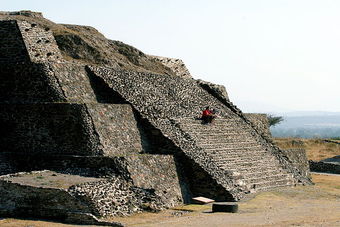
Toltec pyramid at Tula, Hidalgo
Similarities to the pyramid at Chichén Itzá can be seen, including the sloped shape and external steps.
Historicists
The historicists believe that there is truth within the stories told by the Aztecs. Theories abound about the role the Toltecs actually played in Mesoamerica, from the central Mexican valleys all the way down to certain Maya city-states.
- Désiré Charnay, the first archaeologist to work at Tula, Hidalgo, defended the historicist views based on his impression of the Toltec capital. He was the first to note similarities in architectural styles between Tula and Chichén Itzá, a famous Maya archeological site. This led him to posit the theory that Chichén Itzá had been violently taken over by a Toltec military force under the leadership of Kukulcan.
- Following Charnay, the term “Toltec” has since been associated with the influx of certain Central Mexican cultural traits into the Maya sphere of dominance during the late Classic and early Postclassic periods. The Postclassic Maya civilizations of Chichén Itzá, Mayapán, and the Guatemalan highlands have been referred to as “Toltecized” or “Mexicanized” Mayas.
- Some 20th-century historicist scholars, such as David Carrasco, Miguel León Portilla, Nigel Davies and H. B. Nicholson, argued that the Toltecs were a distinct ethnic group. This school of thought connected the “Toltecs” to the archaeological site of Tula, which was taken to be the Tollan of Aztec myth.
- Historicists supportive of the ethnic group theory also argue that much of central Mexico was possibly dominated by a “Toltec empire” between the 10th and 12th centuries CE. One possible clue they point to is that the Aztecs referred to several Mexican city-states as Tollan, “Place of Reeds,” such as “Tollan Cholollan.”
- Archaeologist Laurette Sejourné, followed by the historian Enrique Florescano, argued that the “original” Tollan was probably Teotihuacán.
Anti-Historicist
On the other side of the argument lie those who believe that the Aztec stories are clouded by myth and cannot be taken as accurate accounts of the Toltec civilization. Multiple theories place the Toltec and the site of Tula within a more general framework:
- Some scholars argue that the Toltec era is best considered the fourth of the five Aztec mythical “suns” or ages. This fourth sun immediately precedes the fifth sun of the Aztec people, which was prophesied to be presided over by Quetzalcoatl.
- Some researchers argue that the only historically reliable data in the Aztec chronicles are the names of some rulers and possibly some of the conquests ascribed to them.
- Skeptics argue that the ancient city of Teotihuacán and the Aztec city of Tenochtitlan were much more influential sites for Mesoamerican culture than Tula. However, this skeptical school of thought acknowledges that Tula still contributed to central Mexican cultural heritage in unique ways.
- Recent scholarship does not frame Tula, Hidalgo, as the capital of the Toltecs as described in the Aztec accounts. Rather, it takes “Toltec” to mean simply an inhabitant of Tula during its apogee. Separating the term “Toltec” from those of the Aztec accounts, it attempts to find archaeological clues to the ethnicity, history, and social organization of the inhabitants of the site of Tula.
Archeology and Clues
While the residents of the site of Tula, Hidalgo, remain a mysterious group, and their ethnic and social dynamics are obscure, they left behind substantial archeological records that modern scholars have attempted to parse through.
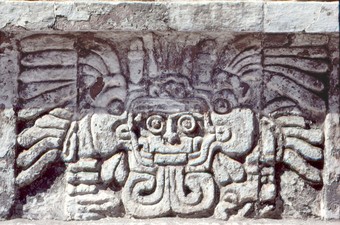
Stone carving of Quetzalcoatl
This powerful feathered serpent deity has deep mythological roots in Aztec stories. He also appears regularly in carvings at Tula.
The city of Tula boasts 15-foot-tall warrior statues carved from stone. These same Atlantean figures, as they are called, also appear at the Mayan sites of Chichén Itzá and Potrero Nuevo.
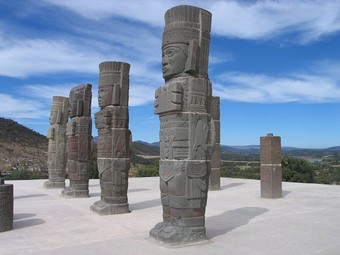
Toltec warrior statues at Tula
These stone statues highlight the artistic style of the city of Tula. They also connect this city with other cultural sites in Mesoamerica.
Tula also boasts intricate carvings of eagles, jaguars, hummingbirds, and butterflies, all of which the Aztec Empire used prolifically. Furthermore, the site of Tula includes two ball courts for the religious rubber ball game that appears in many Mesoamerican civilizations. Along with these distinct relics, the Toltecs also built distinctive pyramids that mirror other sites, such as Chichén Itzá.
Many questions still remain about the inhabitants of this site, including questions about their origin and their demise. This site also raises questions about the flow of influence between multiple Mesoamerican cultures before the rise of the Aztec Empire.
16.5.2: The Aztec People
The Aztecs were a pre-Columbian Mesoamerican people of Central Mexico during the 14th, 15th, and 16th centuries.
Learning Objective
Describe distinguishing factors of Aztec life
Key Points
- The Aztec “empire” was more of a collection of city-states than an empire.
- Mexico City today is built on the ruins of Tenochtitlan, which was the capital of the Aztec empire.
- Agriculture played a key role in the Aztec civilization. Irrigation and floating garden beds allowed people to grow several crops a year.
Key Terms
- altepetl
-
Small, mostly independent city-states that often paid tribute to the Aztec capital of Tenochtitlan.
- Nahuatl
-
The language spoken by the Mexica people who made up the Aztec Triple Alliance, as well as many city-states throughout the region.
- flower wars
-
The form of ritual war where warriors from the Triple Alliance fought with enemy Nahua city-states.
The Aztecs were a pre-Columbian Mesoamerican people of Central Mexico in the 14th, 15th, and 16th centuries. They called themselves Mexica. The Republic of Mexico and its capital, Mexico City, derive their names from the word “Mexica.” The capital of the Aztec empire was Tenochtitlan, built on a raised island in Lake Texcoco. Modern Mexico City is built on the ruins of Tenochtitlan.
From the 13th century, the Valley of Mexico was the heart of Aztec civilization; here the capital of the Aztec Triple Alliance, the city of Tenochtitlan, was built upon raised islets in Lake Texcoco. The Triple Alliance was comprised of Tenochtitlan along with their main allies of Acolhuas of Texcoco and Tepanecs of Tlacopan. They formed a tributary empire expanding its political hegemony far beyond the Valley of Mexico, conquering other city-states throughout Mesoamerica. At its pinnacle, Aztec culture had rich and complex mythological and religious traditions, and reached remarkable architectural and artistic accomplishments. In 1521 Hernán Cortés, along with a large number of Nahuatl-speaking indigenous allies, conquered Tenochtitlan and defeated the Aztec Triple Alliance under the leadership of Hueyi Tlatoani Moctezuma II. Subsequently the Spanish founded the new settlement of Mexico City on the site of the ruined Aztec capital, from where they proceeded to colonize Central America.
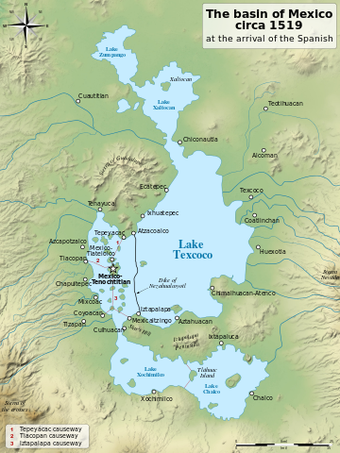
Basin in the Valley of Mexico
Circa 1519, at the time of the arrival of the Spanish.
Politics
The Aztec empire was an example of an empire that ruled by indirect means. Like most European empires, it was ethnically very diverse, but unlike most European empires, it was more of a system of tribute than a single system of government. Although the form of government is often referred to as an empire, in fact most areas within the empire were organized as city-states, known as “altepetl” in Nahuatl. These were small polities ruled by a king (tlatoani) from a legitimate dynasty.
Two of the primary architects of the Aztec empire were the half-brothers Tlacaelel and Montezuma I, nephews of Itzcoatl. Moctezuma I succeeded Itzcoatl as Hueyi Tlatoani (or king) in 1440. Although he was also offered the opportunity to be tlatoani, Tlacaelel preferred to operate as the power behind the throne. Tlacaelel focused on reforming the Aztec state and religious practices. According to some sources, he ordered the burning of most of the extant Aztec books, claiming that they contained lies. He thereupon rewrote the history of the Aztec people, thus creating a common awareness of history for the Aztecs. This rewriting led directly to the curriculum taught to scholars, and promoted the belief that the Aztecs were always a powerful and mythic nation—forgetting forever a possible true history of modest origins. One component of this reform was the institution of ritual war (the flower wars) as a way to have trained warriors, and the necessity of constant sacrifices to keep the Sun moving.
Economics
The Aztec economy can be divided into a political sector, under the control of nobles and kings, and a commercial sector that operated independently of the political sector. The political sector of the economy centered on the control of land and labor by kings and nobles. Nobles owned all land, and commoners got access to farmland and other fields through a variety of arrangements, from rental through sharecropping to serf-like labor and slavery. These payments from commoners to nobles supported both the lavish lifestyles of the high nobility and the finances of city-states. Many luxury goods were produced for consumption by nobles. The producers of featherwork, sculptures, jewelry, and other luxury items were full-time commoner specialists who worked for noble patrons.
Several forms of money were in circulation, most notably the cacao bean. These beans could be used to buy food, staples, and cloth. Around thirty beans would purchase a rabbit, while one father was recorded as selling his daughter for around 200 cacao beans. The Aztec rulers also maintained complex road systems with regular stops to rest and eat every ten miles or so. Couriers walked these roads regularly to ensure they were in good working order and to bring news back to Tenochtitlan.
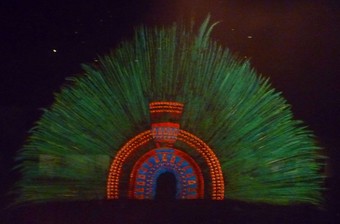
Aztec headdress
The feathers most likely came from a tropical rainforest far away, and the headdress was probably owned by an elite or noble.
Trade also formed a central part of Aztec life. While local commoners regularly paid tribute to the nobles a few times a year, there was also extensive trade with other regions in Mesoamerica. Archeological evidence shows that jade, obsidian, feathers, and shells reached the capital through established trade routes. Rulers and nobles enjoyed wearing these more exotic goods and having them fashioned into expressive headdresses and jewelry.
Architecture and Agriculture
The capital of Tenochtitlan was divided into four even sections called campans. All of these sections were interlaced together with a series of canals that allowed for easy transportation throughout the islets of Lake Texcoco. Commoner housing was usually built of reeds or wood, while noble houses and religious sites were constructed from stone.
Agriculture played a large part in the economy and society of the Aztecs. They used dams to implement irrigation techniques in the valleys. They also implemented a raised bed gardening technique by layering mud and plant vegetation in the lake in order to create moist gardens. These raised beds were called chinampas. These extremely fertile beds could harvest seven different crops each year. Some of the most essential crops in Aztec agriculture included:
- Avocados
- Beans
- Squash
- Sweet Potatoes
- Maize
- Tomatoes
- Amarinth
- Chilies
- Cotton
- Cacao beans
Most farming occurred outside of the busy heart of Tenochtitlan. However, each family generally had a garden where they could grow maize, fruits, herbs, and medicinal plants on a smaller scale.
16.5.3: Aztec Religion
The Aztec religion focused on death, rebirth, and the renewal of the sun. The Aztecs practiced ritual sacrifice, ball games, and bloodletting in order to renew the sun each day.
Learning Objective
Outline the key points of Aztec religious practices and beliefs
Key Points
- The Aztec religion incorporated deities from multiple cultures into its pantheon.
- Ritual sacrifice played an essential role in the religious practice of the Aztecs, and they believed it ensured the sun would rise again and crops would grow.
- The Aztecs utilized a 365-day calendar split into eighteen months based on agricultural traditions and different deities.
Key Terms
- Huitzilopochtli
-
The left-handed hummingbird god that mythically founded Tenochtitlan and represented war and the sun.
- Toxcatl
-
A month in the Aztec sun calendar that represented drought and ritual renewal.
- Mesoamerican ballgame
-
This ritual practice involved a rubber ball that the players hit with their elbows, knees, and hips, and tried to get through a small hoop in a special court.
The Aztecs had at least two
manifestations of the supernatural: tētl and tēixiptla. Tētl,
which the Spaniards and European scholars routinely mistranslated as
“god” or “demon,” referred rather to an
impersonal, mysterious force that permeated the world. Tēixiptla, by
contrast, denoted the physical representations (“idols,”
statues, and figurines) of the tētl as well as the human cultic
activity surrounding this physical representation.
The Aztec religious cosmology included
the physical earth plane, where humans lived, the
underworld (or land of the dead), and the realm of the sky. Due to
the flexible imperial political structure, a large pantheon of gods was incorporated into the larger cultural religious traditions. The
Aztecs also worshipped deities that were central to older
Mesoamerican cultures, such as the Olmecs. Some of the most central
deities that the Aztecs paid homage to included:
- Huitzilopochtli – The “left-handed
hummingbird” god was the god of war and the sun and also the
founder of Tenochtitlan. -
Quetzalcoatl – The feathered serpent
god that represented the morning star, wind, and life. - Tlaloc – The rain and storm god.
- Mixcoatl – The “cloud serpent”
god that was incorporated into Aztec belief and represented war. -
Xipe Totec – The flayed god that was
associated with fertility. This deity was also incorporated from
cultures under the Aztec Triple Alliance umbrella.
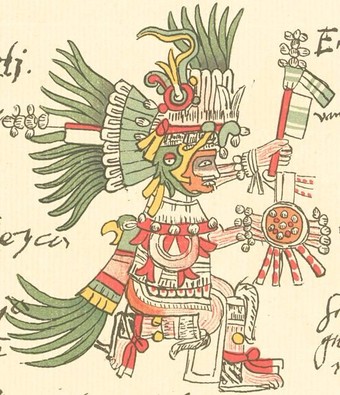
Huitzilopochtli as depicted in the Codex Telleriano-Remensis
This depiction of the war and sun god shows him in all of his warrior and ritual garb.
Founding Myth of Tenochtitlan
Veneration of Huitzilopochtli, the
personification of the sun and of war, was central to the religious,
social, and political practices of the Mexica people. Huitzilopochtli
attained this central position after the founding of Tenochtitlan and
the formation of the Mexica city-state society in the 14th century.
According to myth, Huitzilopochtli directed the wanderers to found a
city on the site where they would see an eagle devouring a snake
perched on a fruit-bearing nopal cactus. (It was said that
Huitzilopochtli killed his nephew, Cópil, and threw his heart on the
lake. Huitzilopochtli honoured Cópil by causing a cactus to grow
over Cópil’s heart.) This legendary vision is pictured on the coat
of arms of Mexico.
Ritual and Sacrifice
Like all other Mesoamerican cultures, the
Aztecs played a variant of the Mesoamerican ballgame, named “tlachtli” or “ollamaliztli” in Nahuatl. The game was played with a ball of solid
rubber, called an olli. The players hit the ball with their hips,
knees, and elbows, and had to pass the ball through a stone ring to
automatically win. The practice of the ballgame carried religious and
mythological meanings and also served as sport. Many times players of
the game were captured during the famous Aztec flower wars with
neighboring rivals. Losers of the game were often ritually sacrificed
as an homage to the gods.
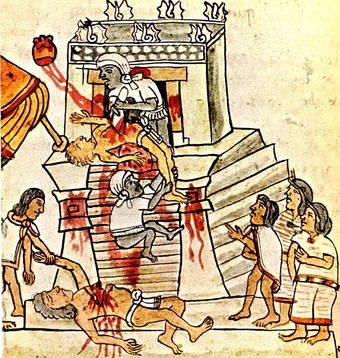
A depiction of human sacrifice in the Codex Magliabechiano
This Spanish rendering of human sacrifices reflects the outsider’s view of these ritual traditions.
While human sacrifice was practiced
throughout Mesoamerica, the Aztecs, if their own accounts are to be
believed, brought this practice to an unprecedented level. For
example, for the reconsecration of the Great Pyramid of Tenochtitlan
in 1487, the Aztecs reported that they sacrificed 80,400 prisoners
over the course of four days, reportedly by Ahuitzotl, the Great
Speaker himself. This number, however, is not universally accepted.
Accounts by the Tlaxcaltecas, the primary enemy of the Aztecs at the
time of the Spanish Conquest, show that at least some of them
considered it an honor to be sacrificed. In one legend, the warrior
Tlahuicole was freed by the Aztecs but eventually returned of his own
volition to die in ritual sacrifice. Tlaxcala also practiced the
human sacrifice of captured Aztec citizens.
Everyone was affected by human
sacrifice, and it should be considered in the context of the religious
cosmology of the Aztec people. It was considered necessary in order
for the world to continue and be reborn each new day. Death and
ritual blood sacrifice ensured the sun would rise again and crops
would continue to grow. Not only were captives and warriors
sacrificed, but nobles would often practice ritual bloodletting
during certain sacred days of the year. Every level of Aztec society
was affected by the belief in the human responsibility to pay homage
to the gods, and anyone could serve as a sacrificial offering.
Priests and Religious Architecture
A noble priest class played an integral
role in the religious worship and sacrifices of Aztec society. They
were responsible for collecting tributes and ensuring there were
enough goods for sacrificial ceremonies. They also trained young men to impersonate various deities for an entire year before being sacrificed on a specific day. These priests were respected
by all of society and were also responsible for practicing ritual
bloodletting on themselves at regular intervals. Priests could
come from the noble or common classes, but they would receive their
training at different schools and perform different functions.
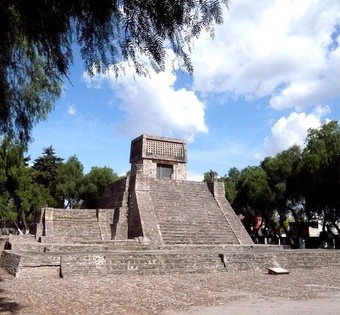
Aztec pyramid of St. Cecilia Acatitlan
This pyramid is typical of Aztec religious architecture. Priests would have stood on the platform at the top to perform religious duties and sacrifices.
Priests performed rituals from
special temples and religious houses. The temples were generally huge
pyramidal structures that were covered over with a new surface every fifty-two years, meaning some pyramids were gigantic in scale. These feats
of architectural display were the sites of large sacrificial
offerings and festivals, where Spanish reports said blood would run
down the steps of the pyramids. The priests often performed smaller daily rituals in
small, dark temple houses where incense and images of important gods
were displayed.
Aztec Calendar

Aztec sun calendar
This calendar shows the eighteen months circling around a representation of the sun.
The Aztecs based their calendar on the
sun and utilized a 365-day religious calendar. It was split into eighteen twenty-day months, and each month had its own religious, and often
agricultural, theme. For example, the late winter month Altcahualo
fell between February 14 and March 5 and represented a time of sowing
crops and fertility. The month Toxcatl occurred in May and was a time
of drought in the central valley. The Aztecs saw this month as a time
of renewal, and it involved a large festival where a young man that had been impersonating the god Tezcatlipoca for a full year would be sacrificed.
16.5.4: The Aztec in the Colonial Period
The Aztec empire was defeated by an alliance between the Spanish and the Confederacy of Tlaxcala.
Learning Objective
Describe the role of the Confederacy of Tlaxcala in the fall of the Aztec empire
Key Points
- The arrival of Hernándo Cortés in 1519 marked the beginning of the end for the Aztec empire.
- Cortés and the Confederacy of Tlaxcala allied to militarily defeat the Aztecs, who were further weakened by a smallpox epidemic in 1520–1521 and subsequent outbreaks.
- Aztec hegemonic structure was re-appropriated to serve the Spanish colonialists.
- Some aspects of Aztec culture, such as the language, survive.
Key Terms
- Tlaxcalan
-
The people of a pre-Columbian city and state in Central Mexico, who helped Cortés conquer the Aztec empire.
- Bartolomé de las Casas
-
(Seville, c. 1484– Madrid, July 18, 1566) Sixteenth-century Spanish historian, social reformer, and Dominican friar. Arriving as one of the first European settlers in the Americas, he participated in the atrocities committed against the Native Americans by the Spanish colonists. In 1515, he reformed his views and advocated before King Charles V, Holy Roman Emperor, on behalf of rights for the natives.
Overview
The Spanish conquest of the Aztec empire was one of the most significant events in the Spanish colonization of the Americas. The Spanish campaign began in February 1519, and was declared victorious on August 13, 1521, when a coalition army of Spanish forces and native Tlaxcalan warriors led by Hernándo Cortés and Xicotencatl the Younger captured the emperor Cuauhtemoc and Tenochtitlan, the capital of the Aztec empire. The fall of the Aztec empire was the key event in the formation of the Spanish overseas empire, with New Spain, which later became Mexico, a major component.
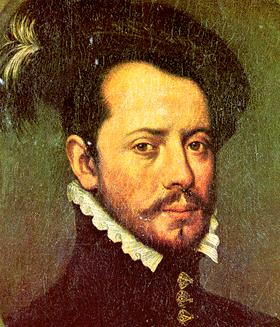
Hernándo Cortés
Conquest of the Aztecs
During the campaign, Cortés was given support from a number of tributaries and rivals of the Aztecs, including the Totonacs and the Tlaxcaltecas, Texcocans, and other city-states particularly bordering Lake Texcoco. In their advance, the allies were tricked and ambushed several times by the people they encountered. After eight months of battles and negotiations, which overcame the diplomatic resistance of the Aztec emperor Moctezuma II to his visit, Cortés arrived in Tenochtitlan on November 8, 1519, where he was welcomed by Moctezuma and took up residence. When news reached Cortés of the death of several of his men during the Aztec attack on the Totonacs in Veracruz, he took the opportunity to take Moctezuma captive; Moctezuma allowed himself to be captured as a diplomatic gesture. Capturing the indigenous ruler was standard operating procedure for Spaniards in their expansion in the Caribbean, so capturing Moctezuma had considerable precedent.
When Cortés left Tenochtitlan to return to the coast and deal with the expedition of Pánfilo de Narváez, Pedro de Alvarado was left in charge. Alvarado allowed a significant Aztec feast to be celebrated in Tenochtitlan, and in the pattern of the earlier massacre in Cholula closed off the square and massacred the celebrating Aztec noblemen. The biography of Cortés by Francisco López de Gómara contains a description of the massacre. The Alvarado massacre at the Main Temple of Tenochtitlan precipitated rebellion by the population of the city. When the captured emperor Moctezuma II, now seen as a mere puppet of the invading Spaniards, attempted to calm the outraged populace, he was killed by a projectile. Cortés, who by then had returned to Tenochtitlan, and his men fled the capital city during the Noche Triste in June 1520. The Spanish, Tlaxcalans, and reinforcements returned a year later, on August 13, 1521, to a civilization that had been wiped out by famine and smallpox. This made it easier to conquer the remaining Aztecs.
Aftermath
To reward Spaniards who participated in the conquest of what is now contemporary Mexico, the Spanish crown authorized grants of native labor in particular indigenous communities via the encomienda. The indigenous were not slaves, chattel bought and sold or removed from their home community, but the system was one of forced labor. The indigenous of Central Mexico had practices rendering labor and tribute products to their polity’s elites, and those elites to the Mexica overlords in Tenochtitlan, so the Spanish system of encomienda was built on pre-existing patterns. The Spanish conquerors in Mexico during the early colonial era lived off the labor of the indigenous. Due to some horrifying instances of abuse against the indigenous peoples, Bishop Bartolomé de las Casas suggested importing black slaves to replace them (he later repented when he saw the even worse treatment given to the black slaves).
Nevertheless, Aztec culture survives today. Modern-day Mexico City is built on the site of the Aztec capital, Tenochtitlan. There are still 1.5 million people who speak the Aztec language of Nahuatl, and part of the Mexica migration story appears on the Mexican flag.
16.6: Native American Cultures in North America
16.6.1: Great Basin Culture
The peoples of the Great Basin area required ease of mobility to follow bison herds and gather seasonally available food supplies.
Learning Objective
Describe the culture of the Great Basin civilizations
Key Points
- Between 10,500 BCE and 9,500 BCE (11,500 – 12,500 years ago), the broad-spectrum, big game hunters of the Great Plains began to focus on a single animal species: the bison.
- Paleo-Indians were not numerous, and population densities were quite low during this time.
- These bison-oriented indigenous peoples inhabited a portion of the North American continent known as the Great Basin.
- The climate in the Great Basin was very arid, which affected the lifestyles and cultures of its inhabitants.
Key Terms
- cultural region
-
A cultural region is inhabited by a culture that does not limit their geographic coverage to the borders of a nation state, or to smaller subdivisions of a state.
- metates
-
A morter and grind stone tool used for processing grain and seeds.
- Numic languages
-
A branch of the Uto-Aztecan language family. Includes seven languages spoken by American Indian peoples traditionally living in the Great Basin, Colorado River Basin, and southern Great Plains.
Between 10,500 BCE and 9,500 BCE (11,500 – 12,500 years ago), the broad-spectrum, big game hunters of the Great Plains began to focus on a single animal species: the bison, an early cousin of the American Bison. The earliest of these bison-oriented hunting traditions is known as the Folsom tradition. Folsom peoples traveled in small family groups for most of the year, returning yearly to the same springs while others favored locations on higher grounds. There they would camp for a few days, moving on after erecting a temporary shelter, making and/or repairing stone tools, or processing meat. Paleo-Indians were not numerous, and population densities were quite low during this time.
These bison-oriented indigenous peoples mostly inhabited a portion of the North American continent known as the “cultural region” of the Great Basin. The Great Basin is the region between the Rocky Mountains and the Sierra Nevada, in what is now modern-day Nevada, Utah, California, Idaho, Wyoming, and parts of Oregon. The original inhabitants of the region are believed to have arrived as early as 10,000 BCE. The climate in the Great Basin was and is very arid; this affected the lifestyles and cultures of its inhabitants.
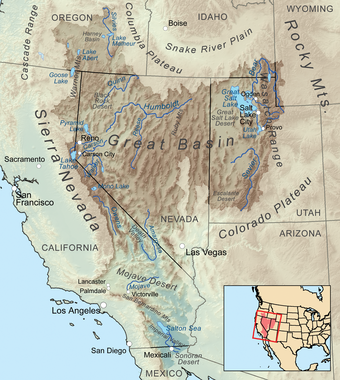
Map showing the Great Basin
The Great Basin is a multi-state endorheic area surrounded by the Pacific Watershed of North America, home to the pre-Columbian indigenous peoples of the Great Basin.
Language
While anthropologists can point to many distinct peoples throughout the region, most peoples of the Great Basin shared certain common cultural elements that distinguished them from other surrounding cultures. Except for the Washoe, most of the groups spoke Numic languages. Some groups may have not have spoken Numic languages, but no relics of their linguistic patterns remain today. There was considerable intermingling among the groups, who lived peacefully and often shared common territories. These groups were all predominantly hunters and gatherers. As a result of these similarities, anthropologists use the terms “Desert Archaic” or more simply “The Desert Culture” to refer collectively to the Great Basin tribes.
Lifeways
Desert Archaic peoples required great mobility to follow seasonally available food supplies. The use of pottery was rare because of its weight, but intricate baskets were woven that could be used to hold water, cook food, and winnow grass seeds. Baskets were also used for storage, including the storage of pine nuts. Heavy items such as metates were cached rather than carried between foraging areas. Agriculture was not practiced within the Great Basin itself, although it was practiced in adjacent areas. The area was too dry, and even modern agriculture in the Great Basin requires either large mountain reservoirs or deep artesian wells. Likewise, the Great Basin tribes had no permanent settlements, although winter villages might be revisited winter after winter by the same groups of families. In the summer groups would split; the largest social grouping was usually the nuclear family, an efficient response to the low density of food supplies.
Religion
Because Great Basin peoples did not come into contact with
European-Americans or African Americans until comparatively later in North
American history, many groups were able to maintain their traditional tribal
religions. These peoples were leading proponents of cultural and religious renewals during
the 19th century. Two Paiute prophets, Wodziwob and Wovoka,
introduced the Ghost Dance as a means to commune with departed loved ones and
bring renewals of buffalo herds and precontact lifeways. The Ute Bear Dance
also emerged in the Great Basin, as did the Sun Dance.
Peyote religion
flourished in the Great Basin as well, particularly among the Ute who used
peyote obtained through trade and other potent ceremonial plants. Ute religious beliefs borrowed heavily from Plains Indians after the
arrival of the horse. Northern and Uncompahgre Ute were among the only group of
indigenous peoples known to create ceremonial pipes out of salmon alabaster and
rare black pipestone found in creeks that border the southeastern slops of the
Uinta Mountains in Utah and Colorado. The Uncompahgre Ute are also among the
first documented peoples to utilize the effect of mechanoluminescene with quartz crystals to generate light in ceremonies used to call
spirits. Special ceremonial rattles were made from buffalo rawhide and
filled with clear quartz crystals collected from the mountains of Colorado and
Utah. These ceremonial rattles were considered extremely powerful religious
objects.
16.6.2: Pacific Coast Culture
The mild climate and abundant natural resources along the Pacific Coast of North America allowed a complex aboriginal culture to flourish.
Learning Objective
Examine how natural resources shaped the cultures of the Pacific Coast
Key Points
- Due to the prosperity made possible by the abundant natural resources in this region, the indigenous peoples of the Pacific Northwest developed complex religious and social ceremonies as well as many fine arts and crafts.
- Music was created to honor the Earth, the creator, ancestors, and all other aspects of the supernatural world.
- Many works of art served practical purposes, such as clothing, tools, weapons of war and hunting, transportation, and shelter; but others were purely aesthetic.
- The Pacific Coast was at one time the most densely populated area of North America in terms of indigenous peoples.
Key Terms
- animism
-
The worldview that non-human entities—such as animals, plants, and inanimate
objects—possess a spiritual essence. - potlatch
-
A ceremony amongst certain American Indian peoples of the Pacific Coast in which gifts are bestowed upon guests and personal property is destroyed in a show of wealth and generosity.
- permaculture
-
Any system of sustainable agriculture that renews natural resources and enriches local ecosystems.
The indigenous peoples of the Pacific Northwest Coast were
composed of many nations and tribal affiliations, each with distinctive
cultural and political identities; but they shared certain beliefs, traditions, and practices, such as the centrality of salmon as a resource and spiritual
symbol.
These nations had time and energy to devote to
the establishment of fine arts and crafts and to religious and social
ceremonies.
The term “Northwest Coast”, or “North West Coast”, is used to
refer to the groups of indigenous people residing along the coasts of British
Columbia, Washington State, parts of Alaska, Oregon, and northern California.
The Pacific Northwest Coast at one time had the most densely
populated areas of indigenous people. The
mild climate and abundant natural resources,
such as cedar and salmon, made possible the rise of a complex
aboriginal culture.
The indigenous people in this region practiced
various forms of forest gardening and fire-stick farming in the forests,
grasslands, mixed woodlands, and wetlands, ensuring that desired food and
medicine plats continued to be available through the use of advanced farming
techniques. Those involved in agricultural development would create
low-intensity fires in order to prevent larger, catastrophic fires and sustain
low-density agriculture in a loose rotation. This is what is known as
permaculture, or any system of sustainable agriculture that renews natural
resources and enriches local ecosystems.
Arts and Crafts
One of
the major cultural elements that began to flourish on the Pacific Northwest Coast
was the use of music and other forms of arts and crafts. Although music
varied in function and expression among indigenous tribes, there were cultural similarities. For
example, some tribes used hand drums made of animal hides as their instrument
of choice, while others used plank or log drums, along with whistlers, wood
clappers, and rattles. However, regardless of the type of instrument used,
music and song were created to accompany ceremonies, dancing, and festivities.
The
principal function of music in this region was to invoke spirituality. Music
was created to honor the Earth, the creator, ancestors, and all other aspects of
the supernatural world. Songs were also used to convey stories and
sometimes were owned by families like property that could be inherited, sold, or given
as a gift to a prestigious guest at a feast. Professional musicians existed in
some communities, and in some nations, those who made musical errors were
punished, usually through shaming. Vocal rhythmic patterns were often complex
and ran counter to rigid percussion beats.
As with music, the creation of art also served as a means of transmitting stories, history, wisdom, and property from generation to generation. Due to the abundance of natural
resources and the affluence of most Northwest tribes, there was plenty of
leisure time to create art. Many works of art served practical purposes, such
as clothing, tools, weapons of war and hunting, transportation, cooking, and
shelter. Others were purely aesthetic.
Art provided indigenous people with a tie to the land
and was a constant reminder of their birth places, lineages, and
nations. One example of this is the use of symbols on totem poles and plank houses of the Pacific Northwest coast.
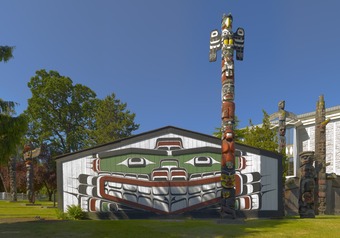
Pacific Coast Art
Tribal art included plank houses and totem poles that served as constant reminders of indigenous peoples’ birth places, lineages, and nations.
Religious and Social
Ceremonies
Other cultural elements that became
established were the religious and social ceremonies of the Pacific Northwest
nations. Although various tribes might
have had their own different mythologies and rituals, “animism” is
said to describe the most common, foundational thread of indigenous peoples’
spiritual or supernatural perspectives in this region. Spiritualism, the supernatural, and the
importance of the environment played such integral roles in day-to-day life.
Therefore, it was not unusual for worldly goods to be adorned with symbols,
crests, and totems that represented some important figure(s) from both the seen
and unseen worlds.
Many of these religious or spiritual symbols would be
present during social ceremonies as well.
The potlatch, a gift-giving feast, was perhaps one of the most significant
social experiences that occurred within Pacific Northwest groups. It was a highly complex event where
people gathered in order to commemorate a specific event such as the raising
of a totem pole or the appointment/election of a new chief. In the potlatch ceremony, the chief would give
highly elaborate gifts to visiting peoples in order to establish his power and
prestige, and by accepting these gifts, the visitors conveyed their approval of
the chief. There were also great feasts and displays of conspicuous
consumption. Groups of dancers put on elaborate dances and ceremonies. Watching
these performances was considered an honor. Potlatches were held for several
reasons: the confirmation of a new chief, coming of age, tattooing or piercing
ceremonies, initiation into a secret society, marriages, the funeral of a
chief, or a battle victory.
16.6.3: Eastern Woodland Culture
Eastern Woodland Culture refers to the way of life of indigenous peoples in the eastern part of North America between 1,000 BCE and 1,000 CE.
Learning Objective
Analyze how agricultural practices shaped the Eastern Woodland Culture
Key Points
- This time period is widely regarded as a developmental period for the people of this region as they steadily advanced in their means of cultivation, tools and textile manufacture, and use of pottery.
- While the increasing use of agriculture meant the nomadic nature of many groups was supplanted by permanent villages, intensive agriculture did not become the norm for most cultures until the succeeding Mississippian period.
- The Early Woodland period differed from the Archaic period in the following ways: the appearance of permanent settlements, elaborate burial practices, intensive collection and horticulture of starchy seed plants, differentiation in social organization, and specialized activities.
- Due to the similarity of earthworks and burial goods, researchers assume a common body of religious practice and cultural interaction existed throughout the entire region, referred to as the “Hopewellian Interaction Sphere.”
Key Terms
- maize
-
A grain, domesticated by indigenous peoples in Mesoamerica in prehistoric times, known in many English-speaking countries as corn.
- atlatl
-
A wooden stick with a thong or perpendicularly protruding hook on the rear end that grips a grove or socket on the butt of its accompanying spear.
The Eastern Woodland cultural region extended from what is now southeastern Canada, through the eastern United States, down to the Gulf of Mexico. The time in which the peoples of this region flourished is referred to as the Woodland Period. This period is known for its continuous development in stone and bone tools, leather crafting, textile manufacture, cultivation, and shelter construction. Many Woodland hunters used spears and atlatls until the end of the period when those were replaced by bows and arrows. The Southeastern Woodland hunters however, also used blowguns. The major technological and cultural advancements during this period included the widespread use of pottery and the increasing sophistication of its forms and decoration. The growing use of agriculture and the development of the Eastern Agricultural Complex also meant that the nomadic nature of many of the groups was supplanted by permanently occupied villages.
Early Woodland Period (1000–1 BCE)
The
archaeological record suggests that humans in the Eastern Woodlands of North
America were collecting plants from the wild by 6,000 BCE and gradually
modifying them by selective collection and cultivation. In fact, the eastern
United States is one of 10 regions in the world to become an “independent
center of agricultural origin.” Research also indicates that the first appearance of ceramics occurred around 2,500 BCE in parts of Florida and Georgia. What differentiates the Early Woodland period from the Archaic period is the appearance of permanent settlements, elaborate burial practices, intensive collection and horticulture of starchy seed plants, and differentiation in social organization. Most of these were evident in the southeastern United States by 1,000 BCE with the Adena culture, which is the best-known example of an early Woodland culture.
The Adena culture was
centered around what is present-day Ohio and surrounding states and was most
likely a number of related American Indian societies that shared burial
complexes and ceremonial systems. Adena mounds generally ranged in size from 2o
to 300 feet in diameter and served as burial structures, ceremonial sites,
historical markers, and possibly even gathering places. The mounds provided a
fixed geographical reference point for the scattered populations of people
dispersed in small settlements of one to two structures. A typical Adena house
was built in a circular form, 15 to 45 feet in diameter. Walls were made of
paired posts tilted outward that were then joined to other pieces of wood to
form a cone-shaped roof. The roof was covered with bark, and the walls were bark and/or wickerwork.
While the burial mounds created
by Woodland culture peoples were beautiful artistic achievements, Adena artists
were also prolific in creating smaller, more personal pieces of art using
copper and shells. Art motifs that became important to many later American
Indians began with the Adena. Examples of these motifs include the weeping eye
and the cross and circle design. Many works of art revolved around shamanic
practices and the transformation of humans into animals, especially birds,
wolves, bears, and deer, indicating a belief that objects depicting certain
animals could impart those animals’ qualities to the wearer or holder.
Middle Woodland Period (1–500 CE)
The beginning of this period saw a shift of settlement to the interior. As the Woodland period progressed, local and inter-regional trade of exotic materials greatly increased to the point where a trade network covered most of the eastern United States. Throughout the Southeast and north of the Ohio River, burial mounds of important people were very elaborate and contained a variety of mortuary gifts, many of which were not local. The most archaeologically certifiable sites of burial during this time were in Illinois and Ohio. These have come to be known as the Hopewell tradition.
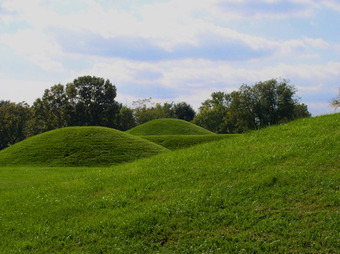
Hopewell mounds
The Eastern Woodland cultures built burial mounds for important people such as these of the Hopewell tradition in Ohio.
The
Hopewellian peoples had leaders, but they were not powerful rulers who could
command armies of soldiers or slaves. It has been posited that these cultures
accorded certain families with special privileges and that these societies were
marked by the emergence of “big-men,” or leaders who were able to acquire
positions of power through their ability to persuade others to agree with them
on matters of trade and religion. It is also likely these rulers gained
influence through the creation of reciprocal obligations with other important
community members. Regardless of their path to power, the emergence of big-men
marked another step toward the development of the highly structured and
stratified sociopolitical organization called the chiefdom, which would
characterize later American Indian tribes. Due to the similarity of earthworks and burial goods, researchers assume a common body of religious practice and cultural interaction existed throughout the entire region (referred to as the “Hopewellian Interaction Sphere”). Such similarities could also be the result of reciprocal trade, obligations, or both between local clans that controlled specific territories. Clan heads were buried along with goods received from their trading partners to symbolize the relationships they had established. Although many of the Middle Woodland cultures are called Hopewellian, and groups shared ceremonial practices, archaeologists have identified the development of distinctly separate cultures during the Middle Woodland period. Examples include the Armstrong culture, Copena culture, Crab Orchard culture, Fourche Maline culture, the Goodall Focus, the Havana Hopewell culture, the Kansas City Hopewell, the Marksville culture, and the Swift Creek culture.
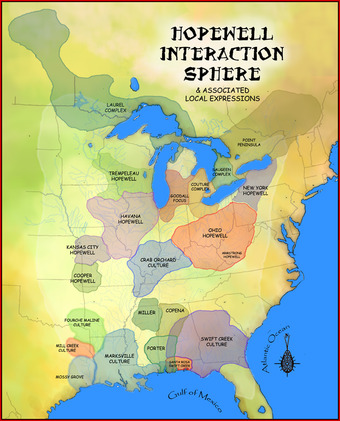
Hopewell Interaction Area and local expressions of the Hopewell tradition
Throughout the Southeast and north of the Ohio River, burial mounds of important people were very elaborate and contained a variety of mortuary gifts, many of which were not local. The most archaeologically certifiable sites of burial during this time were in Illinois and Ohio. These sites were constructed within the Hopewell tradition of Eastern Woodland cultures.
Ceramics during this time were thinner, of better quality, and more decorated than in earlier times. This ceramic phase saw a trend towards round-bodied pottery and lines of decoration with cross-etching on the rims.
Late Woodland Period (500–1000 CE)
The late Woodland period was a time of apparent population dispersal. In most areas, construction of burial mounds decreased drastically, as did long distance trade in exotic materials. Bow and arrow technology gradually overtook the use of the spear and atlatl, and agricultural production of the “three sisters” (maize, beans, and squash) was introduced. While full scale intensive agriculture did not begin until the following Mississippian period, the beginning of serious cultivation greatly supplemented the gathering of plants.
Late Woodland settlements became more numerous, but the size of each one was generally smaller than their Middle Woodland counterparts. It has been theorized that populations increased so much that trade alone could no longer support the communities and some clans resorted to raiding others for resources. Alternatively, the efficiency of bows and arrows in hunting may have decimated the large game animals, forcing tribes to break apart into smaller clans to better use local resources, thus limiting the trade potential of each group. A third possibility is that a colder climate may have affected food yields, also limiting trade possibilities. Lastly, it may be that agricultural technology became sophisticated enough that crop variation between clans lessened, thereby decreasing the need for trade.
In practice, many regions of the Eastern Woodlands adopted the full Mississippian culture much later than 1,000 CE. Some groups in the North and Northeast of the United States, such as the Iroquois, retained a way of life that was technologically identical to the Late Woodland until the arrival of the Europeans. Furthermore, despite the widespread adoption of the bow and arrow, indigenous peoples in areas near the mouth of the Mississippi River, for example, appear never to have made the change.
16.6.4: Southwestern Culture
Environmental changes allowed for many cultural traditions to
flourish and develop similar social structures and religious beliefs.
Learning Objective
Describe the cultural traditions of the Southwest
Key Points
-
Three of the major cultural traditions that
impacted the region include the Paleo-Indian tradition, the Southwestern
Archaic tradition, and the Post-Archaic cultures tradition. - As Southwestern cultural traditions evolved,
tribes transitioned from a hunting-gathering, nomadic experience to more permanent
agricultural settlements. - As various cultures developed over time, many
shared similarities in family structure and religious
beliefs. -
Extensive irrigation systems were developed and were among the largest of the ancient world.
- Elaborate adobe and sandstone buildings were constructed, and highly ornamental and artistic pottery was created.
Key Terms
- irrigation
-
The act or process of irrigating, or the state of being irrigated; especially, the operation of causing water to flow over lands for the purpose of nourishing plants.
- shamanism
-
A practice that involves a practitioner reaching altered states of
consciousness in order to perceive and interact with a spirit world and channel
transcendental energies into this world. - animism
-
The worldview that non-human entities—such as animals, plants, and inanimate
objects—possess a spiritual essence. - sandstone
-
A sedimentary rock produced by the consolidation and compaction of sand, cemented with clay.
Overview
The greater Southwest has long been occupied by
hunter-gatherers and agricultural settlements. This area, comprised of modern-day Colorado, Arizona, New Mexico, Utah, and Nevada, and the
states of Sonora and Chihuahua in northern Mexico, has seen successive
prehistoric cultural traditions since approximately 12,000 years ago. Three of
the major cultural traditions that impacted the region include the
Paleo-Indian tradition, the Southwestern Archaic tradition, and the Post-Archaic
cultures tradition. As various cultures developed over time, many of them shared similarities in family structure and religious beliefs.
Southwestern
Agriculture
Southwestern
farmers probably began experimenting with agriculture by facilitating the
growth of wild grains such as amaranth and chenopods as well as gourds for
their edible seeds and shells. The earliest maize known to have been grown in
the Southwest was a popcorn varietal measuring one to two inches long. It was
not a very productive crop. More productive varieties were developed later by Southwestern
farmers or introduced via Mesoamerica, though the drought-resistant tepary bean
was native to the region. Cotton has been found at archaeological sites dating
to about 1,200 BCE in the Tucson basin and was most likely cultivated by
indigenous peoples in the region. Evidence of tobacco use and possibly the
cultivation of tobacco, dates back to approximately the same time period.
Agave,
especially agave murpheyi, was a major food source of the Hohokam and grown on
dry hillsides where other crops would not grow. Early farmers also possibly cultivated cactus fruit, mesquite bean, and species of wild grasses
for their edible seeds.
Paleolithic peoples utilized
habitats near water sources like rivers, swamps, and marshes, which had an
abundance of fish and attracted birds and game animals. They hunted big game—bison, mammoths, and
ground sloths—who were also attracted to these water sources. A period of relatively wet conditions saw
many cultures in the American Southwest flourish. Extensive irrigation systems
were developed and were among the largest of the ancient world. Elaborate adobe
and sandstone buildings were constructed, and highly ornamental and artistic
pottery was created. The unusual weather conditions could not continue forever,
however, and gave way in time, to the more common arid conditions of the area.
These dry conditions necessitated a more minimal way of life and, eventually,
the elaborate accomplishments of these cultures were abandoned.
During this time, the people of the Southwest
developed a variety of subsistence strategies, all using their own specific
techniques. The nutritive value of weed and grass seeds was discovered and flat
rocks were used to grind flour to produce gruels and breads. The use of
grinding slabs originated around 7,500 BCE and marks the beginning of the Archaic tradition.
Small bands of people traveled throughout the area gathering plants such as cactus
fruits, mesquite beans, acorns, and pine nuts. Archaic people established camps
at collection points, and returned to these places year after year.
The American Indian Archaic culture eventually evolved into
two major prehistoric archaeological culture areas in the American Southwest
and northern Mexico. These cultures, sometimes referred to as Oasisamerica, are
characterized by dependence on agriculture, formal social stratification,
population clusters, and major architecture. One of the major cultures that
developed during this time was the Pueblo peoples, formerly referred to as the
Anasazi. Their distinctive pottery and
dwelling construction styles emerged in the area around 750 CE. Ancestral
Pueblo peoples are renowned for the construction of and cultural achievement
present at Pueblo Bonito and other sites in Chaco Canyon, as well as Mesa
Verde, Aztec Ruins, and Salmon Ruins. Other cultural traditions that developed during this time include the Hohokam
and Mogollon traditions.
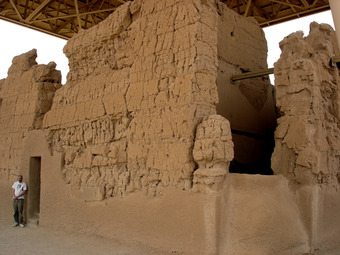
Hohokam House
Photo of the Great House at the Casa Grande Ruins National Monument.
Family and Religion
Paleolithic
peoples in the Southwest initially structured their families and communities
into highly mobile traveling groups of approximately 20 to 50 members, moving
place to place as resources were depleted and additional supplies were needed.
As cultural traditions began to evolve throughout the
Southwest between 7,500 BCE to 1,550 CE, many cultures developed similar
social and religious traditions. For the Pueblos and other Southwest American Indian communities, the transition from a hunting-gathering, nomadic experience to more
permanent agricultural settlements meant more firmly established families and
communities. Climate
change that occurred about 3,500 years ago during the Archaic period, however,
changed patterns in water sources, dramatically decreasing the population of
indigenous peoples. Many family-based groups took shelter in caves and rock
overhangs within canyon walls, many of which faced south to capitalize on
warmth from the sun during the winter. Occasionally, these peoples lived in
small, semi-sedentary hamlets in open areas.
Many Southwest tribes during
the Post-Archaic period lived in a range of structures that included small
family pit houses, larger structures to house clans, grand pueblos,
and cliff-sited dwellings for defense.
These communities developed complex networks that stretched across the Colorado
Plateau, linking hundreds of neighborhoods and population centers.
While southwestern tribes developed more permanent family
structures and established complex communities, they also developed and shared a
similar understanding of the spiritual and natural world. Many of the tribes
that made up the Southwest Culture practiced animism and shamanism. Shamanism encompasses the premise that
shamans are intermediaries or messengers between the human world and the spirit
worlds. At the same time, animism encompasses the beliefs that there is no separation
between the spiritual and physical (or material) world, and that souls or spirits exist
not only in humans, but also in some other animals, plants, rocks, and geographic
features such as mountains or rivers, or other entities of the natural
environment, including thunder, wind, and shadows.
Conclusion
Although at present there are a variety of contemporary cultural traditions that exist in the greater
Southwest, many of these traditions still incorporate similar religious aspects
that are found in animism and shamanism. Some of these cultural traditions include
the Yuman-speaking peoples inhabiting the Colorado River valley, the uplands,
and Baja California; O’odham peoples of southern Arizona and northern Sonora; and the Pueblo peoples of Arizona and New Mexico.
16.6.5: Mississippian Culture
Mississippian cultures lived in the modern-day United States in the Mississippi valley from 800 to 1540.
Learning Objective
Describe the economies of Mississippian cultures
Key Points
- Mississippian cultures lived in the Mississippi valley, Ohio, Oklahoma, and surrounding areas.
- The “three sisters”- corn, squash, and beans- were the three most important crops.
- Spanish explorer Hernando de Soto brought diseases and cultural changes that eventually contributed to the decline of many Mississippian cultures.
Key Terms
- three sisters
-
Corn, squash, and beans. The three most important crops for Mississippian cultures.
- mounds
-
Formations made of earth that were used as foundations for Mississippian culture structures.
The Mississippian Period lasted from approximately 800 to 1540 CE. It’s called “Mississippian” because it began in the middle Mississippi River valley, between St. Louis and Vicksburg. However, there were other Mississippians as the culture spread across modern-day US. There were large Mississippian centers in Missouri, Ohio, and Oklahoma.
A number of cultural traits are recognized as being characteristic of the Mississippians. Although not all Mississippian peoples practiced all of the following activities, they were distinct from their ancestors in adoption of some or all of the following traits:
- The construction of large, truncated earthwork pyramid mounds, or platform mounds. Such mounds were usually square, rectangular, or occasionally circular. Structures (domestic houses, temples, burial buildings, or other) were usually constructed atop such mounds.
- Maize-based agriculture. In most places, the development of Mississippian culture coincided with adoption of comparatively large-scale, intensive maize agriculture, which supported larger populations and craft specialization.
- The adoption and use of riverine (or more rarely marine) shells as tempering agents in their shell tempered pottery.
- Widespread trade networks extending as far west as the Rockies, north to the Great Lakes, south to the Gulf of Mexico, and east to the Atlantic Ocean.
- The development of the chiefdom or complex chiefdom level of social complexity.
- A centralization of control of combined political and religious power in the hands of few or one.
- The beginnings of a settlement hierarchy, in which one major center (with mounds) has clear influence or control over a number of lesser communities, which may or may not possess a smaller number of mounds.
- The adoption of the paraphernalia of the Southeastern Ceremonial Complex (SECC), also called the Southern Cult. This is the belief system of the Mississippians as we know it. SECC items are found in Mississippian-culture sites from Wisconsin to the Gulf Coast, and from Florida to Arkansas and Oklahoma. The SECC was frequently tied in to ritual game-playing.
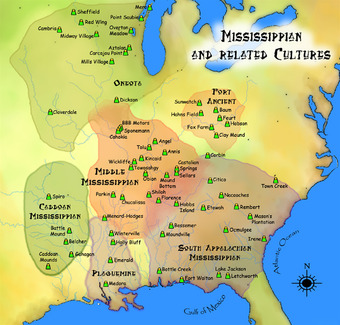
Mississippian Cultures
There were a number of Mississippian cultures, with most spreading from the Middle Mississippian area.
Although hunting and gathering plants for food was still important, the Mississippians were mainly farmers. They grew corn, beans, and squash, called the “three sisters” by historic Southeastern Indians. The “sisters” provided a stable and balanced diet, making a larger population possible. Thousands of people lived in some larger towns and cities.
A typical Mississipian town was built near a river or creek. It covered about ten acres of ground, and was surrounded by a palisade, a fence made of wooden poles placed upright in the ground. A typical Mississippian house was rectangular, about 12 feet long and 10 feet wide. The walls of a house were built by placing wooden poles upright in a trench in the ground. The poles were then covered with a woven cane matting. The cane matting was then covered with plaster made from mud. This plastered cane matting is called “wattle and daub”. The roof of the house was made from a steep “A” shaped framework of wooden poles covered with grass woven into a tight thatch.
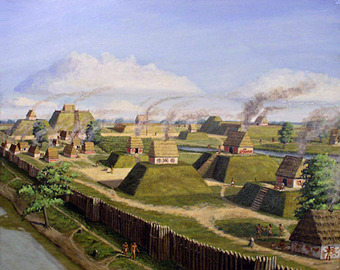
Platform Mounds
Mississippian cultures often built structures on top of their mounds such as homes and burial buildings.
Mississippian cultures, like many before them, built mounds. Though other cultures may have used mounds for different purposes, Mississippian cultures typically built structures on top of them. The type of structures constructed ran the gamut: temples, houses, and burial buildings.
Mississippian artists produced unique art works. They engraved shell pendants with animal and human figures, and carved ceremonial objects out of flint. They sculpted human figures and other objects in stone. Potters molded their clay into many shapes, sometimes decorating them with painted designs.
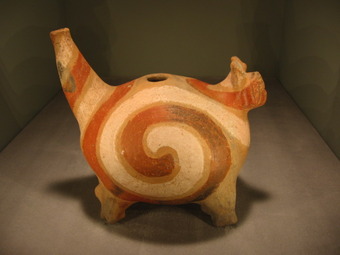
Mississippian Underwater Panther
The Nashville area was a major population center during this period. Thousands of Mississippian-era graves have been found in the city, and thousands more may exist in the surrounding area. There were once many temple and burial mounds in Nashville, especially along the Cumberland River.
Decline of the Mississippians
Hernando de Soto was a Spanish explorer who, from 1539-43, lived with and spoke to many Mississippian cultures. After his contact, their cultures were relatively unaffected directly by Europeans, though they were indirectly. Since the natives lacked immunity to new infectious diseases, such as measles and smallpox, epidemics caused so many fatalities that they undermined the social order of many chiefdoms. Some groups adopted European horses and changed to nomadism. Political structures collapsed in many places.By the time more documentary accounts were being written, the Mississippian way of life had changed irrevocably. Some groups maintained an oral tradition link to their mound-building past, such as the late 19th-century Cherokee. Other Native American groups, having migrated many hundreds of miles and lost their elders to diseases, did not know their ancestors had built the mounds dotting the landscape. This contributed to the myth of the Mound Builders as a people distinct from Native Americans.
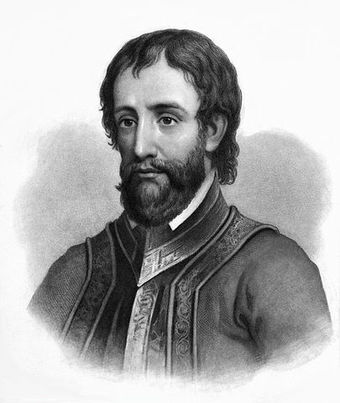
Hernando de Soto
Engraving by Lambert A. Wilmer (1858)
Mississippian peoples were almost certainly ancestral to the majority of the American Indian nations living in this region in the historic era. The historic and modern day American Indian nations believed to have descended from the overarching Mississippian Culture include: the Alabama, Apalachee, Caddo, Cherokee, Chickasaw, Choctaw, Muscogee Creek, Guale, Hitchiti, Houma, Kansa, Missouria, Mobilian, Natchez, Osage, Quapaw, Seminole, Tunica-Biloxi, Yamasee, and Yuchi.
